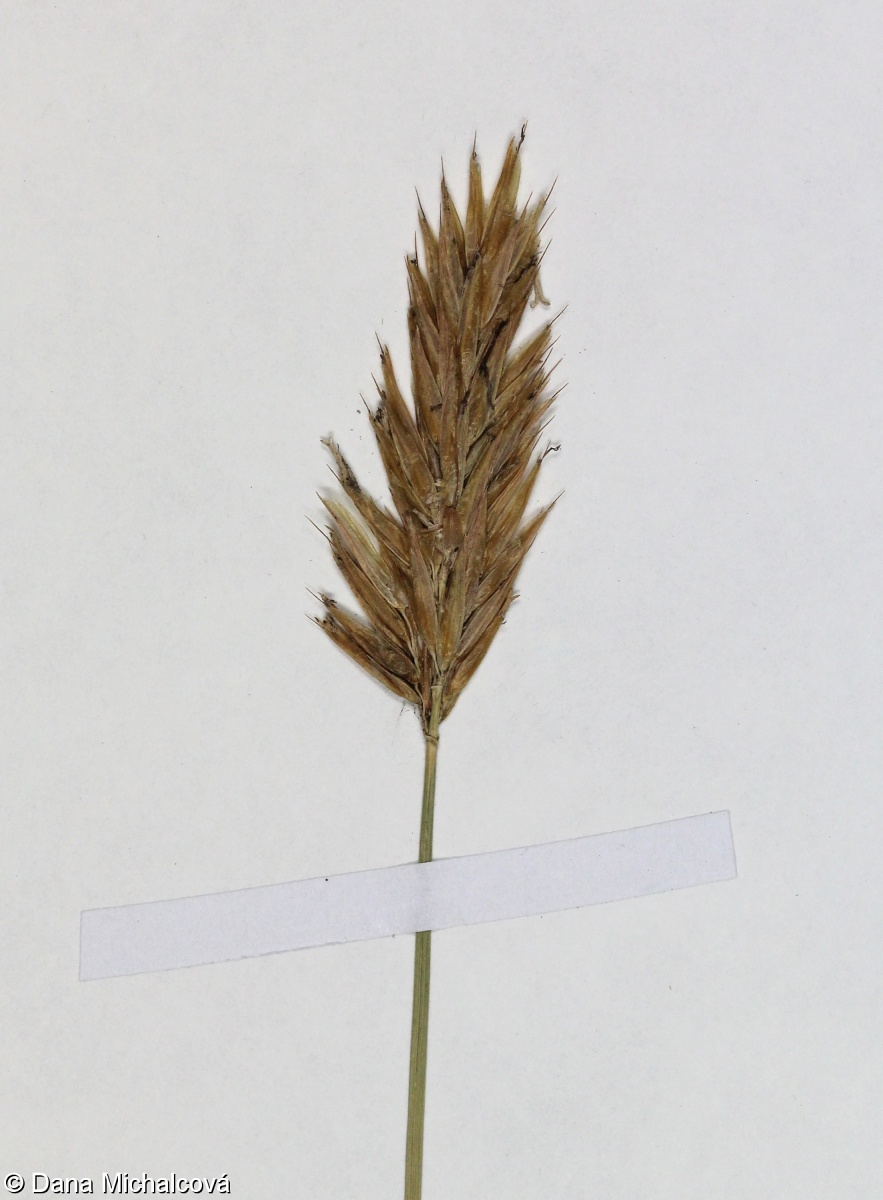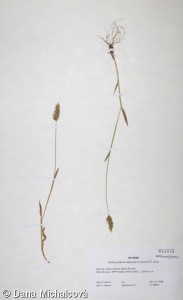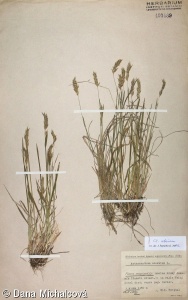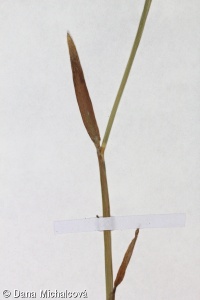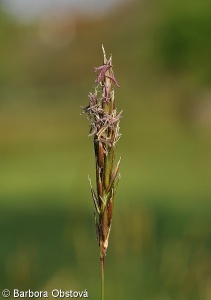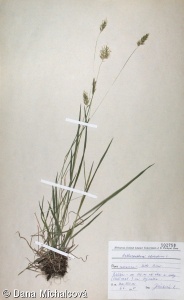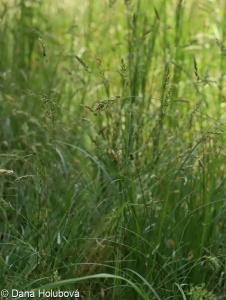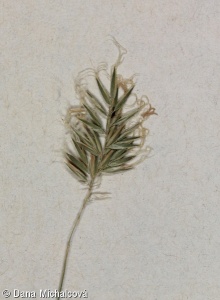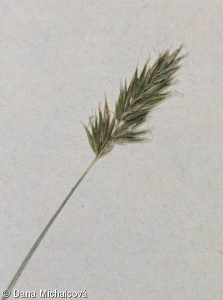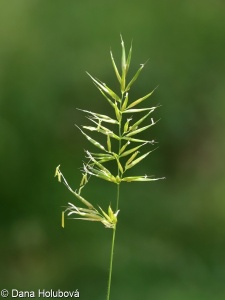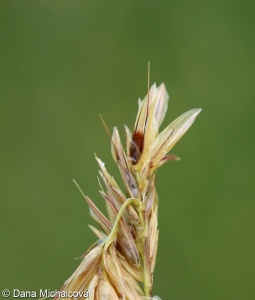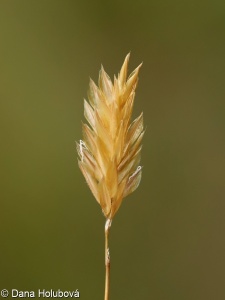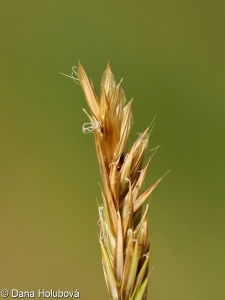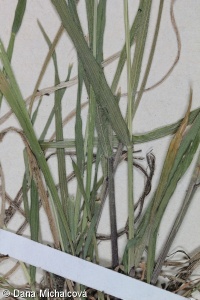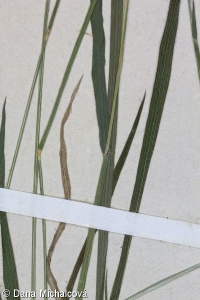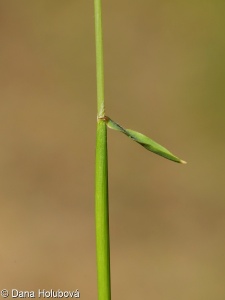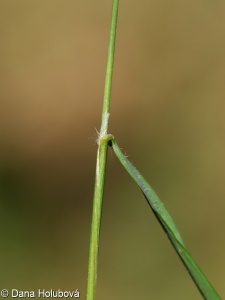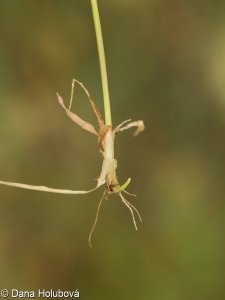Anthoxanthum odoratum aggr.
Data
download factsheetHabitus and growth type
-
Plant height [m]: 0.33?
Plant height
Plant height is measured in meters and relates to fully developed mature generative plants growing in the wild. The data were taken preferably from Kleyer et al. (2008), Guarino et al. (2019), Kaplan et al. (2019), French Flora database (2020) and complemented by additional sources such as national and regional floras. Each species is characterized by a mean value calculated across available datasets.
Data source and citation
Axmanová, I. (2022). Plant height. – www.FloraVeg.EU.
Further references
Guarino, R., La Rosa, M. & Pignatti, S. (Eds) (2019). Flora d'Italia, volume 4. Bologna: Edagricole.
French Flora database (baseflor), project of Flore et végétation de la France et du Monde: CATMINAT. Available at http://philippe.julve.pagesperso-orange.fr/catminat.htm [accessed June 2020]
Kaplan, Z., Danihelka, J., Chrtek, J. Jr., Kirschner, J., Kubát, K., Štěpánek, J. & Štech, M. (Eds) (2019). Klíč ke květeně České republiky [Key to the flora of the Czech Republic]. Ed. 2. Praha: Academia.
Kleyer, M., Bekker, R. M., Knevel, I. C., Bakker, J. P., Thompson, K., Sonnenschein, M., … Peco, B. (2008). The LEDA Traitbase: A database of life-history traits of the Northwest European flora. Journal of Ecology, 96(6), 1266–1274. https://doi.org/10.1111/j.1365-2745.2008.01430.x -
Life span: Perennial?
Life span
Life span categories reflect the length of life duration of individual species. Annual plants finish their life cycle within one growing season. Biennial or short-lived plants are overwintering, growing only vegetatively in the first season and fruiting in the following season/s. Most of them are monocarpic, i.e. they finish their life cycle after producing fruits. Perennial plants can stay in vegetative form for several seasons, repeatedly flower and produce seeds (polycarpic strategy). Some species were assigned to more than one category because of their different life span in different parts of Europe, e.g., annual life span in northern Europe and biennial or short-lived life span in the Mediterranean.
The data were compiled from Klotz et al. 2002, Săvulescu (1952-76) and complemented by additional sources such as national and regional floras. If possible we used also the life form assessment to decide the life span category.
Categories
- Annual
- Biennial or short-lived
- Perennial
Data source and citation
Dřevojan, P., Čeplová, N., Štěpánková, P., & Axmanová, I. (2023). Life span. – www.FloraVeg.EU.
Further references
Klotz, S., Kühn, I. & Durka, W. (2002). BIOLFLOR – Eine Datenbank zu biologisch-ökologischen Merkmalen der Gefäßpflanzen in Deutschland. Schriftenreihe für Vegetationskunde, 38, 1–334.
Săvulescu, T. (Ed.) (1952–1976). Flora Republicii Populare Române – Flora Republicii Socialiste România. Vols 1–13. București: Editura Academiei Republicii Populare Române, Academia Republicii Socialiste România. -
Life form: Hemicryptophyte?
Life form
The main categories of the life-form classification follow the system of Raunkiaer (1934), which is based on the position of the buds that survive the unfavourable season. In addition, we use auxiliary categories where it is possible to use finer differentiation.
At least one main category is assigned to each species, while some species can belong to more than one main category. Phanerophyte is a perennial woody or succulent plant with regenerative buds higher than 30 cm above the soil surface (includes trees, shrubs and tall succulents, excludes lianas and epiphytes). Chamaephyte is a perennial herb, low woody plant or succulent with regenerative buds above ground level, but not taller than 30 cm (includes dwarf shrubs, semi-shrubs, small succulents and some herbs). Hemicryptophyte is a perennial or biennial herb with regenerative buds on shoots at the ground level. Geophyte is a perennial plant with regenerative buds located belowground, usually with bulbs, tubers, or rhizomes. Hydrophyte is a plant that survives unfavourable seasons by means of buds that are at the bottom of a water body. Therophyte is a summer- or winter-annual herb that survives adverse seasons only as seeds and germinates in autumn, winter or spring. Epiphyte is either parasitic or non-parasitic plant that grows on other plants.
Auxiliary categories are only used for some species. Tree is a phanerophyte with a stem and a crown. Shrub is a phanerophyte branching from the stem base. Woody liana is a phanerophyte in the form of a long-stemmed woody vine. Semi-shrub (i.e. suffruticose chamaephyte) is a chamaephyte with shoots that usually grow straight up, bear leaves and flowers and die at the end of the growing season except for their lower part, which bears buds. Dwarf shrub is a chamaephyte with shoots that lignify instead of dying. Herbaceous liana is a hemicryptophyte, geophyte or therophyte with climbing aboveground stems.
Data were compiled from several databases and floras (Săvulescu 1952–1976, Horváth et al. 1995, Klotz et al. 2002, Tavşanoğlu & Pausas 2018, Guarino et al. 2019, Kaplan et al. 2019, French Flora database), European broad-scale studies (Wagner et al. 2017, Giulio et al. 2020), and different online sources (e.g. GreekFlora.gr). In the case of different assessments in original data sources, we critically revised them using additional sources.
Categories
- Phanerophyte
- Chamaephyte
- Hemicryptophyte
- Geophyte
- Hydrophyte
- Therophyte
- Epiphyte
- Tree
- Shrub
- Woody liana
- Semi-shrub
- Dwarf shrub
- Herbaceous liana
Data source and citation
Dřevojan, P., Čeplová, N., Štěpánková, P., & Axmanová, I. (2023) Life form. – www.FloraVeg.EU.
Further references
Giulio, S., Acosta, A. T. R., Carboni, M., Campos, J. A., Chytrý, M., Loidi, J., … Marcenò, C. (2020). Alien flora across European coastal dunes. Applied Vegetation Science, 23(3), 317–327. https://doi.org/10.1111/avsc.12490
GreekFlora.gr. Available at https://www.greekflora.gr/ [accessed June 2020]
Guarino, R., La Rosa, M. & Pignatti, S. (Eds) (2019). Flora d'Italia, volume 4. Bologna: Edagricole.
Horváth, F., Dobolyi, Z. K., Morschhauser, T., Lõkös, L., Karas, L. & Szerdahelyi, T. (1995). Flóra adatbázis 1.2 – taxonlista és attribútum-állomány. [FLORA database 1.2 – lists of taxa and relevant attributes.] Vácrátót: FLÓRA munkacsoport, MTA-ÖBKI, MTM Növénytára.
French Flora database (baseflor), project of Flore et végétation de la France et du Monde: CATMINAT. Available at http://philippe.julve.pagesperso-orange.fr/catminat.htm [accessed June 2020]
Kaplan Z., Danihelka J., Chrtek J. Jr., Kirschner J., Kubát K., Štěpánek J. & Štech M. (Eds.) (2019). Klíč ke květeně České republiky [Key to the flora of the Czech Republic]. Ed. 2. Praha: Academia.
Klotz, S., Kühn, I. & Durka, W. (2002). BIOLFLOR – Eine Datenbank zu biologisch-ökologischen Merkmalen der Gefäßpflanzen in Deutschland. Schriftenreihe für Vegetationskunde, 38, 1–334.
Raunkiaer C. (1934). The life forms of plants and statistical plant geography. Oxford: Clarendon Press.
Tavşanoğlu, Ç., & Pausas, J. (2018). A functional trait database for Mediterranean Basin plants. Scientific Data, 5, 180135. https://doi.org/10.1038/sdata.2018.135
Wagner, V., Chytrý, M., Jiménez-Alfaro, B., Pergl, J., Hennekens, S., Biurrun, I., … Pyšek, P. (2017). Alien plant invasions in European woodlands. Diversity and Distributions, 23(9), 969–981. https://doi.org/10.1111/ddi.12592
Săvulescu, T. (Ed.) (1952–1976). Flora Republicii Populare Române – Flora Republicii Socialiste România. Vols 1–13. București: Editura Academiei Republicii Populare Române, Academia Republicii Socialiste România.
Leaf
-
Specific leaf area [mm2/mg]: 24.31?
Specific leaf area
Specific leaf area (SLA) is the ratio of leaf area to leaf dry mass expressed in mm2 mg-1, reflecting the amount of energy plants invest in their leaf biomass. SLA is related to plant growth strategy with respect to water availability and temperature. The data were taken preferably from Kleyer et al. (2008), Tavşanoğlu & Pausas (2018), Ladouceur et al. (2019) and complemented by additional sources. Each species is characterized by a mean value calculated across available datasets.
Data source and citation
Axmanová, I. (2022). Specific leaf area. – www.FloraVeg.EU.
Further references
Kleyer, M., Bekker, R. M., Knevel, I. C., Bakker, J. P., Thompson, K., Sonnenschein, M., … Peco, B. (2008). The LEDA Traitbase: A database of life-history traits of the Northwest European flora. Journal of Ecology, 96(6), 1266–1274. https://doi.org/10.1111/j.1365-2745.2008.01430.x
Ladouceur, E., Bonomi, C., Bruelheide, H., Klimešová, J., Burrascano, S., Poschlod, P., … Jiménez-Alfaro, B. (2019). The functional trait spectrum of European temperate grasslands. Journal of Vegetation Science, 30(5), 777–788. https://doi.org/10.1111/jvs.12784
Tavşanoğlu, Ç., & Pausas, J. (2018). A functional trait database for Mediterranean Basin plants. Scientific data, 5, 180135. https://doi.org/10.1038/sdata.2018.135
Flower
-
Flowering period: March-August?
Flowering period
The months of the beginning and end of flowering across Europe are given. The data were compiled from Kaplan et al. 2019, French Flora database and Guarino et al. 2019. For each species, we provide a maximal flowering range across available sources.
Data source and citation
Axmanová, I. (2022). Flowering period. – www.FloraVeg.EU.
Further references
Guarino, R., La Rosa, M. & Pignatti, S. (Eds) (2019). Flora d'Italia, volume 4. Bologna: Edagricole.
GreekFlora.gr. Available at https://www.greekflora.gr/ [accessed June 2020]
French Flora database (baseflor), project of Flore et végétation de la France et du Monde: CATMINAT. Available at http://philippe.julve.pagesperso-orange.fr/catminat.htm [accessed June 2020]
Kaplan Z., Danihelka J., Chrtek J. Jr., Kirschner J., Kubát K., Štěpánek J. & Štech M. (eds) (2019) Klíč ke květeně České republiky [Key to the flora of the Czech Republic]. Ed. 2. – Academia, Praha.
Ladouceur, E., Bonomi, C., Bruelheide, H., Klimešová, J., Burrascano, S., Poschlod, P., … Jiménez-Alfaro, B. (2019). The functional trait spectrum of European temperate grasslands. Journal of Vegetation Science, 30(5), 777–788. https://doi.org/10.1111/jvs.12784
Săvulescu, T. (Ed.) (1952–1976). Flora Republicii Populare Române – Flora Republicii Socialiste România. Vols 1–13. București: Editura Academiei Republicii Populare Române, Academia Republicii Socialiste România.
Fruit, seed and dispersal
-
Seed mass [mg]: 0.56?
Seed mass
Seed mass represent the mean weight of 1000 seeds in a dry state, measured in grams. The data were taken preferably from Kleyer et al. (2008), Hintze et al. (2013), García-Gutiérrez et al. (2018) and Seed Information Database (Royal Botanic Gardens Kew 2021) and complemented by additional sources such as national and regional floras. Each species is characterized by a mean value calculated across available datasets. Upon request, minimum, maximum and median values are also available.
Data source and citation
Axmanová, I. (2022). Seed mass. – www.FloraVeg.EU.
Further references
García-Gutiérrez, T., Jiménez-Alfaro, B., Fernández-Pascual, E., & Müller, J. V. (2018). Functional diversity and ecological requirements of alpine vegetation types in a biogeographical transition zone. Phytocoenologia, 77–89. https://doi.org/10.1127/phyto/2017/0224
Hintze, C., Heydel, F., Hoppe, C., Cunze, S., König, A., & Tackenberg, O. (2013). D3: The Dispersal and Diaspore Database – Baseline data and statistics on seed dispersal. Perspectives in Plant Ecology, Evolution and Systematics, 15(3), 180–192. https://doi.org/10.1016/j.ppees.2013.02.001
Kleyer, M., Bekker, R. M., Knevel, I. C., Bakker, J. P., Thompson, K., Sonnenschein, M., … Peco, B. (2008). The LEDA Traitbase: A database of life-history traits of the Northwest European flora. Journal of Ecology, 96(6), 1266–1274. https://doi.org/10.1111/j.1365-2745.2008.01430.x
Royal Botanic Gardens Kew. (2021). Seed Information Database (SID). Version 7.1. Available at: http://data.kew.org/sid/ [accessed May 2021] -
Dispersal mode: Local non-specific dispersal, Anthropochory?
Dispersal mode
Dispersal mode (dispersal syndrome, dispersal type) characterizes plant dispersal ability. It is represented by following categories: (i) local non-specific dispersal, which combines self-dispersal (autochory) and dispersal initiated by wind, where diaspores do not have any efficient special dispersal features, including several dispersal modes (namely ballochory, blastochory, boleochory, barochory); (ii) myrmecochory (ant dispersal); (iii) wind dispersal (anemochory), diaspores have special dispersal features such as hem, pappus, trichomes, dusty seeds or the species are tumbleweeds; (iv) animal dispersal includes dyszoochory, i.e. diaspores foraged by animals, which sometimes hide them as stock; (v) endozoochory, i.e. dispersal in animal gastrointestinal tract, and (vi) epizoochory, i.e., dispersal of diaspores attached on animal fur; special case is the (vii) anthropochory, i.e. human dispersal and (viii) hydrochory (water dispersal). Please note that hydrochory is not considered in the dispersal distance classes classification.
The dispersal modes are mainly estimated from species' morphological characteristics.
Categories
- Local non-specific dispersal
- Myrmecochory
- Anemochory
- Dyszoochory
- Endozoochory
- Epizoochory
- Anthropochory
- Hydrochory
Data source and citation
Lososová Z., Axmanová I., Chytrý M., Midolo G., Abdulhak S., Karger D.N., Renaud J., Van Es J., Vittoz P. & Thuiller W. (2023). Seed dispersal distance classes and dispersal modes for the European flora. Global Ecology and Biogeography, 32(9), 1485–1494.
Further references
Vittoz P. & Engler R. (2007). Seed dispersal distances: a typology based on dispersal modes and plant traits. Botanica Helvetica, 117, 109–124.
-
Dispersal distance class: 2, 7?
Dispersal distance class
Dispersal distance classes are represented by ordered classes from 1 to 7, where classes 1 to 6 represent a gradient from short-distance dispersal to long-scale dispersal. The last class represents the dispersal mediated by humans. For species of the last class the assignment to the previous six classes and natural dispersal mode are given. The assignment of individual plants follows Lososová et al. (2023), a dataset prepared using the adjusted methodology of Vittoz & Engler (2007).
To assign plants into dispersal distance classes, several plant characteristics were obtained from various sources, namely plant height, life form, predominant dispersal mode, seed mass, typical habitat, plant geographical origin and information on dispersal by humans. In contrast to the original approach of Vittoz & Engler (2007), definitions of the dispersal distance classes were slightly modified.
Class 1 contains species shorter than 0.3 m. Their seeds do not have any specific dispersal features. Species are mostly self-dispersed, although seed dispersal can be initiated by wind, e.g., by shaking the fruit, which causes the diaspore to fall down. Class 2 is the most species-rich, including species with non-specific local dispersal strategy taller than 0.3 m. Class 3 includes ant-dispersed (myrmecochorous) species and wind-dispersed (anemochorous) forest herbs and dwarf shrubs. Class 4 is the least species-rich, including less efficient wind-dispersed woody plants and tumbleweeds. Class 5 includes wind-dispersed herbs and shrubs of open habitats and wind-dispersed trees with more efficient dispersal units (with trichomes). Class 6 includes species with different modes of animal dispersal. They can be dyszoochorous (i.e., foraged by animals, which sometimes hide them as stock), endozoochorous (i.e., dispersal in animal gastrointestinal tract), and epizoochorous (i.e., dispersal on animal fur). Finally, class 7 contains human-dispersed (antropochorous) species.
The species of the last class are also classified into one of the previous six classes based on their natural dispersal mode. Only classes 1-6 can be used in studies at the landscape scale where it is assumed that most species disperse naturally. All seven classes can be used in studies at a broader geographical scale where rare events of long-distance human dispersal are important.
Classes
- Class 1. Small plants without any specific dispersal features. Mean dispersal distance: 0.1–1 m.
- Class 2. Tall plants without any specific dispersal features. Mean dispersal distance: 1–5 m.
- Class 3. Wind-dispersed plants of forest understorey and ant-dispersed plants. Mean dispersal distance: 2–15 m.
- Class 4. Tumbleweed and wind dispersed trees and shrubs without trichomes. Mean dispersal distance: 40–150 m.
- Class 5. Wind dispersed trees and shrubs with trichomes and wind dispersal plants of open habitats. Mean dispersal distance: 10–500 m.
- Class 6. Animal dispersed plants. Mean dispersal distance: 400–1500 m.
- Class 7. Human dispersed plants. Mean dispersal distance: 500 –5000 m.
Data source and citation
Lososová Z., Axmanová I., Chytrý M., Midolo G., Abdulhak S., Karger D.N., Renaud J., Van Es J., Vittoz P. & Thuiller W. (2023). Seed dispersal distance classes and dispersal modes for the European flora. Global Ecology and Biogeography, 32(9), 1485–1494.
Further references
Vittoz P. & Engler R. (2007). Seed dispersal distances: a typology based on dispersal modes and plant traits. Botanica Helvetica, 117, 109–124.
Trophic mode
-
Parasitism and mycoheterotrophy: autotroph?
Parasitism and mycoheterotrophy
In plant parasitism, two groups can be distinguished based on two different mechanisms. The first group of parasitic plants includes those directly parasitizing on another plant. These plants are called haustorial parasites. Using a specialized organ, the haustorium, they attach themselves to other plants and uptake resources from the host’s vascular bundles. The second group comprises mycoheterotrophic plants, which parasitise fungi via mycorrhizal interactions and gain organic carbon from them. Plants in both groups display variable dependence on their host organism.
The functional categorization of parasitic plants has been a topic of an active debate that is still ongoing. The traditional categories are based on the ability to perform photosynthesis (photosynthetic hemiparasites and non-green holoparasites) and the location of the haustoria (root and stem parasites) (Heide-Jørgensen 2008). However, such a classification system struggles with phenomena such as rudimentary photosynthesis in some species, variable photosynthetic activity throughout the life cycle, and the existence of parasitic plants that integrate with their host to such an extent that they can be considered endophytic. For the functional classification of European parasitic plants, we have adopted the most recent classification system proposed by Teixeira-Costa & Davis (2021) with small further modifications. This system relies primarily on ontogenetic development and strategies of attachment to the host. The values of other important functional traits, including photosynthetic capacity, type of vascular bundle connection, development of the primary haustorium, and location of haustoria on the host are also well discriminated by the categories of Teixeira-Costa & Davis (2021).
- Euphytoid hemiparasites represent a great majority of European parasitic plants. These are root-parasitic, photosynthetic plants that germinate independently of the presence of the host and produce exclusively lateral (secondary) haustoria with a vascular connection to the host xylem only. All European species belong to the Orobanchaceae and Santalaceae. Teixeira-Costa & Davis (2021) call these plants “euphytoid parasites”, but we prefer keeping “hemiparasites” in the name of this category to preserve this well-established term.
- Obligate root parasites comprise all species of non-green root holoparasites (such as Orobanche spp.), but also hemiparasitic species, which are more dependent on their host than the euphytoid hemiparasites due to the absence of photosynthesis in the initial life stage (e.g. Striga spp.). Most of them produce terminal (primary) haustoria immediately after seed germination, triggered by chemical cues of host presence. However, several European obligate root parasites (holoparasitic Lathraea spp., hemiparasitic Tozzia alpina, and perennial species of Rhynchocorys) deviate from this developmental pattern by germinating without host cues and not forming primary haustoria (Těšitel 2016).
- Mistletoes are epiphytic parasitic shrubs. They germinate on host stems or branches and penetrate the host with a primary haustorium. The level of photosynthesis varies among the mistletoe species from efficient to rudimentary. The most widespread mistletoes of Loranthus and Viscum display efficient photosynthesis. By contrast, the Mediterranean genus Arceuthobium connects to the host’s phloem and takes up substantial amounts of carbon from the host (Rey et al. 1991). The photosynthetic capacity of Arceuthobium is probably limited, as shown by physiological data from their American congeners (Miller & Tocher 1975).
- Parasitic vines are herbaceous parasites that attach themselves to the stems of their hosts by haustoria that are formed on the parasite stem. They germinate on the soil surface and, during a period of independent growth, forage for a host to which they attach themselves with lateral haustoria. All European parasitic vines belong to the genus Cuscuta and have only rudimentary photosynthesis, which however has an important function in seedling metabolism and seed production (McNeal et al. 2007).
- Endophytic parasites (or Endoparasites) are the most integrated with the host body among parasitic plants. They are rootless, stemless and leafless, grow most of their life as filaments within their host and are only visible outside the host body when flowering. The holoparasitic Cytinus hypocistis and Pilostyles haussknechtii are the only species of this category in the European flora.
In mycoheterotrophic plants, the initial developmental stages (gametophytes in lycophytes and ferns or belowground seedling stages of other plants) are not green, obtaining all their organic carbon and other resources from the fungus. The adult stages are still dependent on the mycorrhizal fungi as a source of water and mineral nutrients but vary in their dependence on heterotrophic carbon: there is a continuum from autotrophy, where the adult plants no longer use fungal carbon (this strategy is further called ‘initial mycoheterotrophy’), through mixotrophy (the adult plants combine autotrophic with heterotrophic nutrition; further called ‘partial mycoheterotrophy’), to heterotrophy (further called ‘full mycoheterotrophy’) (Merckx 2012). Two categories are distinguished here:
- Initial and partial mycoheterotrophs have been combined here into a common category because the level of carbon heterotrophy may be low or depend on light conditions (Preiss et al. 2010), which makes it difficult to distinguish between partial mycoheterotrophs and initial mycoheterotrophs. Furthermore, new partially mycoheterotrophic species may be identified due to the advancement of the stable-isotope methodology (e.g., Schiebold et al. 2018). This category includes mycoheterotrophic species from Ophioglossaceae, Lycopodiaceae, green mycoheterotrophic species from Ericaceae (subfamily Pyroloideae) and all green Orchidaceae. Species that obtain nearly all of their carbon from mycorrhizal fungi but still contain chlorophyll and can be photosynthetically active, such as Corallorhiza trifida (Zimmer et al. 2008, Cameron et al. 2009) and Limodorum species (Bellino et al. 2014) from Orchidaceae, are also included in this category. Interestingly, achlorophyllous individuals, which completely lack chlorophyll and wholly depend on their mycorrhizal fungi, are rarely found among partially mycoheterotrophic species (e.g., in the genera Cephalanthera and Epipactis).
- Full mycoheterotrophs include achlorophyllous species that cannot photosynthesize and obtain carbon only from mycorrhizal fungi during their life cycle. Neottia nidus-avis and Epipogium aphyllum from Orchidaceae and Hypopitys monotropa and H. hypophegea from Ericaceae are the only species in this category in the European flora.
Categories
- autotroph
- euphytoid hemiparasite
- obligate root parasite
- mistletoe
- parasitic vine
- endophytic parasite
- initial or partial mycoheterotroph
- full mycoheterotroph
Data source and citation
Těšitel, J., Těšitelová, T., Fahs, N., Blažek, P., Knotková, K. & Axmanová, I. (2024): Parasitism and mycoheterotrophy. – www.FloraVeg.eu.
Further references
Bellino, A., Alfani, A., Selosse, M.-A., Guerrieri, R., Borghetti, M., & Baldantoni, D. (2014). Nutritional regulation in mixotrophic plants: New insights from Limodorum abortivum. Oecologia, 175(3), 875–885. https://doi.org/10.1007/s00442-014-2940-8
Cameron, D. D., Preiss, K., Gebauer, G., & Read, D. J. (2009). The chlorophyll-containing orchid Corallorhiza trifida derives little carbon through photosynthesis. New Phytologist, 183(2), 358–364. https://doi.org/10.1111/j.1469-8137.2009.02853.x
Heide-Jørgensen, H. S. (2008). Parasitic flowering plants. Brill, Leiden.
Kubat, R. & Weber, H. C. (1987). Zur Biologie von Rhynchcorys elephas (L.) Griseb. (Scrophulariaceae). Beiträge zur Biologie der Pflanzen, 62, 239–250.
McNeal, J. R., Arumugunathan, K., Kuehl, J. V., Boore, J. L., & dePamphilis, C. W. (2007). Systematics and plastid genome evolution of the cryptically photosynthetic parasitic plant genus Cuscuta (Convolvulaceae). BMC Biology, 5(1), 55. https://doi.org/10.1186/1741-7007-5-55
Merckx, V. S. F. T. (Ed). (2012). Mycoheterotrophy: the biology of plants living on fungi. Springer, Berlin.
Miller, J. R., & Tocher, R. D. (1975). Photosynthesis and respiration of Arceuthobium tsugense (Loranthaceae). American Journal of Botany, 62(7), 765–769. https://doi.org/10.2307/2442068
Preiss, K., Adam, I. K. U., & Gebauer, G. (2010). Irradiance governs exploitation of fungi: Fine-tuning of carbon gain by two partially myco-heterotrophic orchids. Proceedings of the Royal Society B: Biological Sciences, 277(1686), 1333–1336. https://doi.org/10.1098/rspb.2009.1966
Rey, L., Sadik, A., Fer, A., & Renaudin, S. (1991). Trophic relations of the dwarf mistletoe Arceuthobium oxycedri with its host Juniperus oxycedrus. Journal of Plant Physiology, 138(4), 411–416. https://doi.org/10.1016/S0176-1617(11)80515-8
Schiebold, J. M.-I., Bidartondo, M. I., Lenhard, F., Makiola, A., & Gebauer, G. (2018). Exploiting mycorrhizas in broad daylight: Partial mycoheterotrophy is a common nutritional strategy in meadow orchids. Journal of Ecology, 106(1), 168–178. https://doi.org/10.1111/1365-2745.12831
Teixeira-Costa, L., & Davis, C. C. (2021). Life history, diversity, and distribution in parasitic flowering plants. Plant Physiology, 187(1), 32–51. https://doi.org/10.1093/plphys/kiab279
Těšitel, J. (2016). Functional biology of parasitic plants: A review. Plant Ecology and Evolution, 149(1), Article 1. https://doi.org/10.5091/plecevo.2016.1097
Těšitel, J., Těšitelová, T., Blažek, P., & Lepš, J. (2016). Parasitism and mycoheterotrophy. www.pladias.cz.
Weber, H. C. (1973). Zur Biologie von Tozzia alpina L. (Standort, Wirtspflanzen, Entwicklung und Parasitismus). Beiträge zur Biologie der Pflanzen, 49, 237–249.
Zimmer, K., Meyer, C., & Gebauer, G. (2008). The ectomycorrhizal specialist orchid Corallorhiza trifida is a partial myco-heterotroph. New Phytologist, 178(2), 395–400. https://doi.org/10.1111/j.1469-8137.2007.02362.x -
Carnivory: non-carnivorous?
Carnivory
Carnivorous plants attract, trap and kill their prey, mainly insects, small crustaceans and protozoans, and subsequently absorb the nutrients from the dead bodies. Carnivorous species occur in environments with extremely low availability of nutrients, especially nitrogen and phosphorus, e.g. mires. In contrast, they usually have enough light (open habitats) and high water table or precipitation levels (Fleischmann et al. 2017). Therefore, the carnivory improves the intake of nutrients essential for growth but sparse in the environment, while the main source of energy for these plants is photosynthesis (Fleischmann et al. 2017).
Although there is a variety of morphological structures and trapping mechanisms, all the traps evolved as more or less complicated modifications of leaves with glandulous hairs (Hedrich & Fukushima 2021). Examples of active-hunting carnivorous plants include Aldrovanda with snap traps and Utricularia with suction traps. Typical representatives of the passive-trapping species can be found in the genera Drosera, Drosophyllum and Pinguicula, which have specific types of adhesive leaves. Another passive mechanism is the pitfall trap of Sarracenia (Hedrich & Fukushima 2021). Some species can combine adhesive traps with active movement of either glands or parts of the leaves (e.g. some species of Drosera).
The carnivory evolved independently in relatively distant lineages of angiosperms. There are carnivorous families within the orders Poales, Oxalidales, Caryophyllales, Ericales and Lamiales (Hedrich & Fukushima 2021). This convergent evolution of carnivory was possible because the traits associated with carnivorous syndrome from trap development through prey digestion to nutrient absorption are modifications of structures found also in non-carnivorous ancestors, where these originally served as defending mechanisms (Hedrich & Fukushima 2021).
In Europe, there are only three native carnivorous families, namely Droseraceae, Drosophyllaceae (order Caryophyllales), and Lentibulariaceae (Lamiales). Carnivorous plants have however often been planted and imported to Europe. Some of these non-native carnivorous species introduced to Europe can also survive in natural habitats and establish vital populations. For example, the species of Sarracenia (Sarraceniaceae, Ericales), native to North America, have nowadays scattered secondary occurrences across western and northwestern Europe.
Categories
- carnivorous
- non-carnivorous
Data source and citation
Axmanová, I. (2023): Carnivory. – www.FloraVeg.eu.
Further references
Fleischmann, A., Schlauer, J., Smith, S. A., & Givnish, T. J. (2017). Evolution of carnivory in angiosperms. In Ellison, A. & Adamec, L. (Eds.), Carnivorous Plants: Physiology, ecology, and evolution (p. 22–41). Oxford University Press. https://doi.org/10.1093/oso/9780198779841.003.0003
Hedrich, R., & Fukushima, K. (2021). On the Origin of Carnivory: Molecular Physiology and Evolution of Plants on an Animal Diet. Annual Review of Plant Biology, 72(1), 133–153. https://doi.org/10.1146/annurev-arplant-080620-010429 -
Symbiotic nitrogen fixation: no nitrogen-fixing symbionts?
Symbiotic nitrogen fixation
Plants that are able to form a symbiosis with nitrogen-fixing bacteria are classified as nitrogen-fixing plants or nitrogen fixers. Specific bacteria are able to fix atmospheric nitrogen in a way to make it directly accessible to the plants (Franche et al. 2009). For providing nitrogen to the plant, the bacteria receive carbon in return (Crews, 1999, Dilworth et al., 2008). When forming a symbiosis with vascular plants, these bacteria usually inhabit the roots of their symbiont, forming so called (root-)nodules (Akkermans & Houwers, 1983, Fyson & Sprent, 1980, Loureiro et al., 1994). Three different symbiotic relationships between vascular plants and bacteria can be distinguished: (1) with the endosymbiotic cyanobacteria Nostoc, (2) with rhizobia (e.g. Allorhizobium, Bradyrhizobium, Mesorhizobium, Rhizobium and Sinorhizobium) and (3) with Frankia, so-called actinorhizal plants (Bond 1983, Pawlowski & Sprent 2007, Sprent 2008, Benson 2016, Tedersoo et al., 2018). Nitrogen fixation is not a completely phylogenetically conserved trait but evolved and disappeared a few times in the evolution of plants. For the first time it evolved in the Cycadales in Gymnosperms (symbiosis with cyanobacteria, plant species not native to Europe). Most of the nitrogen-fixing plants are however phylogenetically related and recruit from the so-called “Nitrogen-fixing clade” sensu Soltis et al. (1995). Only the family Zygophyllaceae (associated with rhizobia) and the non-native Gunnera, the only genus recorded in Europe associated with Nostoc, do not belong to this clade, representing the exceptions in Angiosperms. Only five native taxa (the genus Alnus, Hippophae rhamnoides, Myrica gale, Elaeagnus angustifolia and Coriaria myrtifolia) and some non-native species with sporadic occurrence are associated with Frankia in Europe. The largest number of nitrogen-fixing species form symbiosis with rhizobia. This includes almost all Fabaceae (uncertain genera and likely exceptions, respectively, are known only very few occurring in Europe: among others this includes Cercis, Erinacea, Gonocytisus, Hammatolobium, Podocytisus, Dorycnopsis (all native), Gleditsia, Cytisopsis, Styphnolobium, Gymnocladus (not native), plus Zygophyllaceae (with uncertain genera Balanites, Seetzenia and Tetraena occurring in Europe).
Assignment was done on the genus-level. Although rare cases of species-specific differences concerning the symbiotic nitrogen fixation status within one genus are known worldwide, for the European flora the general consent that the status is conserved on the genus level is still accepted. Assignment of “likely” or “unlikely” symbiosis with rhizobia is mainly based on their phylogenetic position where there has been no scientific study investigating the nitrogen fixation status of the genus directly or if studies showed diverging results.
Categories
- symbiosis with rhizobia
- likely symbiosis with rhizobia
- unlikely symbiosis with rhizobia
- symbiosis with frankia
- symbiosis with cyanobacteria
- no nitrogen-fixing symbionts
Data source and citation
Fahs, N., Blažek, P., Těšitel, J. & Axmanová, I. (2023). Symbiotic nitrogen fixation. – www.FloraVeg.eu.
Further references
Benson D. R. (2016). Frankia & actinorhizal plants. Available at https://frankia.mcb.uconn.edu/ [accessed on 1 Feb 2021]
Blažek, P. & Lepš, J. (2016). Symbiotic nitrogen fixation. – www.pladias.cz.
Bond, G. (1983). Taxonomy and distribution of non-legume nitrogen-fixing systems. In J. C. Gordon & C. T. Wheeler (Eds.), Biological nitrogen fixation in forest ecosystems: Foundations and applications (pp. 55–87). Springer Netherlands. https://doi.org/10.1007/978-94-009-6878-3_3
Crews, T. E. (1999). The presence of nitrogen fixing legumes in terrestrial communities: Evolutionary vs ecological considerations. Biogeochemistry, 46(1), 233–246. https://doi.org/10.1007/BF01007581
Dilworth M. J., James E. K., Sprent J. I., & Newton W. E. (Eds). (2008). Nitrogen-Fixing Leguminous Symbioses. Springer Netherlands.
Franche, C., Lindström, K., & Elmerich, C. (2009). Nitrogen-fixing bacteria associated with leguminous and non-leguminous plants. Plant and Soil, 321(1), 35–59. https://doi.org/10.1007/s11104-008-9833-8
Fyson, A., & Sprent, J. I. (1980). A Light and Scanning Electron Microscope Study of Stem Nodules in Vicia faba L. Journal of Experimental Botany, 31(123), 1101–1106.
Loureiro, M. F., DE Faria, S. M., James, E. K., Pott, A., & Franco, A. A. (1994). Nitrogen-fixing stem nodules of the Legume, Discolobium pulchellum Benth. The New Phytologist, 128(2), 283–295. https://doi.org/10.1111/j.1469-8137.1994.tb04012.x
Pawlowski, K., & Sprent, J. I. (2008). Comparison Between Actinorhizal And Legume Symbiosis. In K. Pawlowski & W. E. Newton (Eds.), Nitrogen-fixing Actinorhizal Symbioses (pp. 261–288). Springer Netherlands. https://doi.org/10.1007/978-1-4020-3547-0_10
Soltis, D. E., Soltis, P. S., Morgan, D. R., Swensen, S. M., Mullin, B. C., Dowd, J. M., & Martin, P. G. (1995). Chloroplast gene sequence data suggest a single origin of the predisposition for symbiotic nitrogen fixation in angiosperms. Proceedings of the National Academy of Sciences of the United States of America, 92(7), 2647–2651.
Sprent, J. I. (2008). Evolution and Diversity of Legume Symbiosis. In M. J. Dilworth, E. K. James, J. I. Sprent, & W. E. Newton (Eds.), Nitrogen-fixing Leguminous Symbioses (pp. 1–21). Springer Netherlands. https://doi.org/10.1007/978-1-4020-3548-7_1
Tedersoo, L., Laanisto, L., Rahimlou, S., Toussaint, A., Hallikma, T., & Pärtel, M. (2018). Global database of plants with root-symbiotic nitrogen fixation: NodDB. Journal of Vegetation Science, 29(3), 560–568. https://doi.org/10.1111/jvs.12627
Taxon origin
-
Origin in Europe: Native?
Origin in Europe
Origin in Europe was assessed according to the geographic origin of the species. Native taxa are plants that are native to at least part of Europe, although some of them are nowadays alien in other European regions. Species introduced intentionally or unintentionally by humans to Europe from other continents are alien (non-native) plants. We distinguished two categories of alien plants according to their residence time. Archaeophytes are plants introduced to Europe until the Middle Ages, while neophytes are plants introduced after 1500 AD. Data were compiled from Pyšek et al. (2012), GloNAF database (van Kleunen et al 2019), Verloove (2019), Euro+Med database (2021), POWO database (POWO 2021), complemented by additional sources such as national and regional floras.
Categories
- Native
- Archeophyte
- Neophyte
Data source and citation
Axmanová, I. (2022). Origin in Europe. – www.FloraVeg.EU.
Further references
van Kleunen, M., Pyšek, P., Dawson, W., Essl, F., Kreft, H., Pergl, J. et al. (2019). The Global Naturalized Alien Floras (GloNAF) database. Ecology, 100(1):e02542. https://doi.org/10.1002/ecy.2542
Euro+Med (2021). Euro+Med PlantBase – the information resource for Euro-Mediterranean plant diversity. Available at http://ww2.bgbm.org/EuroPlusMed/query.asp [accessed May 2021]
POWO (2021). Plants of the World Online. Facilitated by the Royal Botanic Gardens, Kew. Available at http://www.plantsoftheworldonline.org/ [accessed May 2021]
Pyšek P., Danihelka J., Sádlo J., Chrtek J. Jr., Chytrý M., … Tichý L. (2012) Catalogue of alien plants of the Czech Republic (2nd edition): checklist update, taxonomic diversity and invasion patterns. Preslia 84(2), 155–255.
Verloove, F. (2019). Manual of the Alien Plants of Belgium. Available at http://alienplantsbelgium.be/ [accessed May 2019]
Ecology
-
Environmental relationships
-
Substrate humidity relationship: Mesic?
Substrate humidity relationship
Categories of substrate humidity do not reflect fine differences of various habitats, on the contrary, they are defined very broadly. These categories can be derived also from the ordinal scale for moisture (1-12) defined by Ellenberg et al. (1991). Plants adapted to growing in dry soils, or soils that frequently dry out, are assigned to a category Dry, which corresponds to the first four degrees of the Ellenberg scale (1-4). Accordingly, plants of mesic habitats are assigned to the category Mesic (5 and 6 of the Ellenberg scale), plants of wet to soaked, poorly aerated soils are in the category Wet (7-9), and finally, aquatic plants are assigned to the category Water (10-12). If available, we used Ellenberg-type indicator values aggregated to broader categories, in other cases, categories were assigned according to the knowledge of local experts.
Data were compiled from several sources available across Europe, namely the indicator-value datasets for Great Britain (Hill et al. 2000), Cantabrian Range in Spain (Jiménez-Alfaro et al. 2021), France (Julve 2015), Germany (Ellenberg et al. 2001, taken from Ellenberg & Leuschner 2010), Switzerland (Landolt et al. 2010), Austria (Karrer 1992), Czech Republic (Chytrý et al. 2018), Hungary (Borhidi 1995), Ukraine (Didukh 2011), Italy (Guarino & La Rosa 2019, with additional corrections by R. Guarino), Southern Aegean region of Greece (Böhling et al. 2002) and European mires (Hájek et al. 2020).
Categories
- Dry
- Mesic
- Wet
- Water
Data source and citation
Axmanová, I. (2022). Substrate humidity relationship. – www.FloraVeg.EU.
Further references
Böhling, N., Greuter, W. & Raus, T. (2002). Zeigerwerte der Gefäßpflanzen der Südägäis (Griechenland) [Indicator values of the vascular plants in the Southern Aegean (Greece)]. Braun-Blanquetia, 32, 1–108.
Borhidi, A. (1995). Social behaviour types, the naturalness and relative ecological indicator values of the higher plants in the Hungarian flora. Acta Botanica Hungarica, 39, 97–181.
Chytrý, M., Tichý, L., Dřevojan, P., Sádlo, J. & Zelený, D. (2018). Ellenberg-type indicator values for the Czech flora. Preslia, 90, 83–103.
Didukh Ya.P. (2011). The ecological scales for the species of Ukrainian flora and their use in synphytoindication. Kyiv: Phytosociocentre.
Ellenberg, H., Weber, H. E., Düll, R., Wirth, V., Werner, W. & Paulißen, D. (1991). Zeigerwerte von Pflanzen in Mitteleuropa. Scripta Geobotanica, 18, 1–248.
Ellenberg, H. & Leuschner, C. (2010). Zeigerwerte der Pflanzen Mitteleuropas. In: Ellenberg H. & Leuschner, C., Vegetation Mitteleuropas mit den Alpen. Stuttgart: Verlag Eugen Ulmer.
French Flora database (baseflor), project of Flore et végétation de la France et du Monde: CATMINAT. Available at http://philippe.julve.pagesperso-orange.fr/catminat.htm [accessed June 2020]
Guarino, R., La Rosa, M. & Pignatti, S. (Eds) (2019). Flora d'Italia, volume 4. Bologna: Edagricole.
Hill, M.O., Roy, D.B., Mountford, J.O., & Bunce, R.G.H. (2000). Extending Ellenberg’s indicator values to a new area: an algorithmic approach. Journal of Applied Ecology, 37, 3–15.
Jiménez-Alfaro, B., Carlón, L., Fernández-Pascual, E., Acedo, C., Alfaro-Saiz, E., Alonso Redondo, R., … Vázquez, V. M. (2021). Checklist of the vascular plants of the Cantabrian mountains. Mediterranean Botany, 42, e74570.
Karrer, G. (1992). Österreichische Waldboden-Zustandsinventur. Teil VII: Vegetationsökologische Analysen. Mitteilungen der forstlichen Bundesversuchsanstalt Wien, 168, 193-242.
Landolt, E., Bäumler, B., Erhardt, A., Hegg, O., Klötzli, F., Lämmler, W., … Wohlgemuth, T. (2010). Flora indicativa – Ökologische Zeigerwerte und biologische Kennzeichen zur Flora der Schweiz und der Alpen. Bern: Haupt Verlag. -
Substrate reaction relationship: Acidic?
Substrate reaction relationship
Categories of substrate reaction do not reflect fine differences of various habitats, on the contrary, they are defined very broadly. These categories can be derived also from the ordinal scale for reaction (1-9) defined by Ellenberg et al. (1991). Plants adapted to growing in very acidic soils are assigned to a category Acidic, which corresponds to the first four degrees of the Ellenberg scale (1-4). Accordingly, plants of intermediate habitats are assigned to the category Slightly acidic (5 and 6 of the Ellenberg scale), plants of calcium-rich substrates are in the category Alkaline (7-9). If available, we used Ellenberg-type indicator values aggregated to broader categories, in other cases, categories were assigned according to the knowledge of local experts.
Data were compiled from several sources available across Europe, namely the indicator-value datasets for Great Britain (Hill et al. 2000), Cantabrian Range in Spain (Jiménez-Alfaro et al. 2021), France (Julve 2015), Germany (Ellenberg et al. 2001, taken from Ellenberg & Leuschner 2010), Switzerland (Landolt et al. 2010), Austria (Karrer 1992), Czech Republic (Chytrý et al. 2018), Hungary (Borhidi 1995), Ukraine (Didukh 2011), Italy (Guarino & La Rosa 2019, with additional corrections by R. Guarino), Southern Aegean region of Greece (Böhling et al. 2002).
Categories
- Acidic
- Slightly acidic to near-neutral
- Alkaline
- Indifferent
Data source and citation
Axmanová, I. (2022). Substrate reaction relationship. – www.FloraVeg.EU.
Further references
Böhling, N., Greuter, W. & Raus, T. (2002). Zeigerwerte der Gefäßpflanzen der Südägäis (Griechenland) [Indicator values of the vascular plants in the Southern Aegean (Greece)]. Braun-Blanquetia, 32, 1–108.
Borhidi, A. (1995). Social behaviour types, the naturalness and relative ecological indicator values of the higher plants in the Hungarian flora. Acta Botanica Hungarica, 39, 97–181.
Chytrý, M., Tichý, L., Dřevojan, P., Sádlo, J. & Zelený, D. (2018). Ellenberg-type indicator values for the Czech flora. Preslia, 90, 83–103.
Didukh Ya.P. (2011). The ecological scales for the species of Ukrainian flora and their use in synphytoindication. Kyiv: Phytosociocentre.
Ellenberg, H., Weber, H. E., Düll, R., Wirth, V., Werner, W. & Paulißen, D. (1991). Zeigerwerte von Pflanzen in Mitteleuropa. Scripta Geobotanica, 18, 1–248.
Ellenberg, H. & Leuschner, C. (2010). Zeigerwerte der Pflanzen Mitteleuropas. In: Ellenberg H. & Leuschner, C., Vegetation Mitteleuropas mit den Alpen. Stuttgart: Verlag Eugen Ulmer.
French Flora database (baseflor), project of Flore et végétation de la France et du Monde: CATMINAT. Available at http://philippe.julve.pagesperso-orange.fr/catminat.htm [accessed June 2020]
Guarino, R., La Rosa, M. & Pignatti, S. (Eds) (2019). Flora d'Italia, volume 4. Bologna: Edagricole.
Hájek, M., Dítě, D., Horsáková, V., Mikulášková, E., Peterka, T., Navrátilová, J., … Horsák, M. (2020). Towards the pan-European bioindication system: Assessing and testing updated hydrological indicator values for vascular plants and bryophytes in mires. Ecological Indicators, 116, 106527.
Hill, M.O., Roy, D.B., Mountford, J.O., & Bunce, R.G.H. (2000). Extending Ellenberg’s indicator values to a new area: an algorithmic approach. Journal of Applied Ecology, 37, 3–15.
Jiménez-Alfaro, B., Carlón, L., Fernández-Pascual, E., Acedo, C., Alfaro-Saiz, E., Alonso Redondo, R., … Vázquez, V. M. (2021). Checklist of the vascular plants of the Cantabrian mountains. Mediterranean Botany, 42, e74570.
Karrer, G. (1992). Österreichische Waldboden-Zustandsinventur. Teil VII: Vegetationsökologische Analysen. Mitteilungen der forstlichen Bundesversuchsanstalt Wien, 168, 193-242.
Landolt, E., Bäumler, B., Erhardt, A., Hegg, O., Klötzli, F., Lämmler, W., … Wohlgemuth, T. (2010). Flora indicativa – Ökologische Zeigerwerte und biologische Kennzeichen zur Flora der Schweiz und der Alpen. Bern: Haupt Verlag. -
Nutrient relationship: Mesotrophic?
Nutrient relationship
Categories of nutrient relationship do not reflect fine differences of various habitats, on the contrary, they are defined very broadly. These categories can be derived also from the ordinal scale for reaction (1-9) defined by Ellenberg et al. (1991). Plants adapted to growing in extremely nutrient-poor soils are assigned to a category Dystrophic, which corresponds to the first degree of the Ellenberg scale (1), or if at least some nutrients are available to Oligotrophic category (2-3). Plants of intermediate habitats are assigned to the category Mesotrophic (4, 5), while plants of nutrient-rich substrates are in the category Eutrophic (6-8), or even Hypertrophic (9 degree at the Ellenberg scale). If available, we used Ellenberg-type indicator values aggregated to broader categories, in other cases, categories were assigned according to the knowledge of local experts.
Data were compiled from several sources available across Europe, namely the indicator-value datasets for Great Britain (Hill et al. 2000), Cantabrian Range in Spain (Jiménez-Alfaro et al. 2021), France (Julve 2015), Germany (Ellenberg et al. 2001, taken from Ellenberg & Leuschner 2010), Switzerland (Landolt et al. 2010), Austria (Karrer 1992), Czech Republic (Chytrý et al. 2018), Hungary (Borhidi 1995), Ukraine (Didukh 2011), Italy (Guarino & La Rosa 2019, with additional corrections by R. Guarino), Southern Aegean region of Greece (Böhling et al. 2002).
Categories
- Dystrophic
- Oligotrophic
- Mesotrophic
- Eutrophic
- Hypertrophic
Data source and citation
Axmanová, I. (2022). Nutrient relationship. – www.FloraVeg.EU.
Further references
Böhling, N., Greuter, W. & Raus, T. (2002). Zeigerwerte der Gefäßpflanzen der Südägäis (Griechenland) [Indicator values of the vascular plants in the Southern Aegean (Greece)]. Braun-Blanquetia, 32, 1–108.
Borhidi, A. (1995). Social behaviour types, the naturalness and relative ecological indicator values of the higher plants in the Hungarian flora. Acta Botanica Hungarica, 39, 97–181.
Chytrý, M., Tichý, L., Dřevojan, P., Sádlo, J. & Zelený, D. (2018). Ellenberg-type indicator values for the Czech flora. Preslia, 90, 83–103.
Didukh Ya.P. (2011). The ecological scales for the species of Ukrainian flora and their use in synphytoindication. Kyiv: Phytosociocentre.
Ellenberg, H., Weber, H. E., Düll, R., Wirth, V., Werner, W. & Paulißen, D. (1991). Zeigerwerte von Pflanzen in Mitteleuropa. Scripta Geobotanica, 18, 1–248.
Ellenberg, H. & Leuschner, C. (2010). Zeigerwerte der Pflanzen Mitteleuropas. In: Ellenberg H. & Leuschner, C., Vegetation Mitteleuropas mit den Alpen. Stuttgart: Verlag Eugen Ulmer.
French Flora database (baseflor), project of Flore et végétation de la France et du Monde: CATMINAT. Available at http://philippe.julve.pagesperso-orange.fr/catminat.htm [accessed June 2020]
Guarino, R., La Rosa, M. & Pignatti, S. (Eds) (2019). Flora d'Italia, volume 4. Bologna: Edagricole.
Hájek, M., Dítě, D., Horsáková, V., Mikulášková, E., Peterka, T., Navrátilová, J., … Horsák, M. (2020). Towards the pan-European bioindication system: Assessing and testing updated hydrological indicator values for vascular plants and bryophytes in mires. Ecological Indicators, 116, 106527.
Hill, M.O., Roy, D.B., Mountford, J.O., & Bunce, R.G.H. (2000). Extending Ellenberg’s indicator values to a new area: an algorithmic approach. Journal of Applied Ecology, 37, 3–15.
Jiménez-Alfaro, B., Carlón, L., Fernández-Pascual, E., Acedo, C., Alfaro-Saiz, E., Alonso Redondo, R., … Vázquez, V. M. (2021). Checklist of the vascular plants of the Cantabrian mountains. Mediterranean Botany, 42, e74570.
Karrer, G. (1992). Österreichische Waldboden-Zustandsinventur. Teil VII: Vegetationsökologische Analysen. Mitteilungen der forstlichen Bundesversuchsanstalt Wien, 168, 193-242.
Landolt, E., Bäumler, B., Erhardt, A., Hegg, O., Klötzli, F., Lämmler, W., … Wohlgemuth, T. (2010). Flora indicativa – Ökologische Zeigerwerte und biologische Kennzeichen zur Flora der Schweiz und der Alpen. Bern: Haupt Verlag. -
Salinity relationship: Non-saline?
Salinity relationship
Categories of salinity do not reflect fine differences of various habitats, on the contrary, they are defined very broadly. These categories can be derived also from the ordinal scale for reaction (0-9) defined by Ellenberg et al. (1991). Plants adapted to growing in soils without salt content are assigned to a category Non-saline, which corresponds to the first degree of the Ellenberg scale (0) and it is the prevailing category. Plants of slightly saline habitats are assigned to the category Slightly saline or brackish (1-4 of the Ellenberg scale), while plants of salt-rich substrates are in the category Saline (5-9). If available, we used Ellenberg-type indicator values aggregated to broader categories, in other cases, categories were assigned according to the knowledge of local experts.
Data were compiled from several sources available across Europe, namely the indicator-value datasets for Great Britain (Hill et al. 2000), France (Julve 2015), Germany (Ellenberg et al. 2001, taken from Ellenberg & Leuschner 2010), Switzerland (Landolt et al. 2010), Austria (Karrer 1992), Czech Republic (Chytrý et al. 2018), Hungary (Borhidi 1995), Ukraine (Didukh 2011), Italy (Guarino & La Rosa 2019, with additional corrections by R. Guarino), Southern Aegean region of Greece (Böhling et al. 2002).
Categories
- Non-saline
- Slightly saline or brackish
- Saline
Data source and citation
Axmanová, I. (2022). Salinity relationship. – www.FloraVeg.EU.
Further references
Böhling, N., Greuter, W. & Raus, T. (2002). Zeigerwerte der Gefäßpflanzen der Südägäis (Griechenland) [Indicator values of the vascular plants in the Southern Aegean (Greece)]. Braun-Blanquetia, 32, 1–108.
Borhidi, A. (1995). Social behaviour types, the naturalness and relative ecological indicator values of the higher plants in the Hungarian flora. Acta Botanica Hungarica, 39, 97–181.
Chytrý, M., Tichý, L., Dřevojan, P., Sádlo, J. & Zelený, D. (2018). Ellenberg-type indicator values for the Czech flora. Preslia, 90, 83–103.
Didukh Ya.P. (2011). The ecological scales for the species of Ukrainian flora and their use in synphytoindication. Kyiv: Phytosociocentre.
Ellenberg, H., Weber, H. E., Düll, R., Wirth, V., Werner, W. & Paulißen, D. (1991). Zeigerwerte von Pflanzen in Mitteleuropa. Scripta Geobotanica, 18, 1–248.
Ellenberg, H. & Leuschner, C. (2010). Zeigerwerte der Pflanzen Mitteleuropas. In: Ellenberg H. & Leuschner, C., Vegetation Mitteleuropas mit den Alpen. Stuttgart: Verlag Eugen Ulmer.
French Flora database (baseflor), project of Flore et végétation de la France et du Monde: CATMINAT. Available at http://philippe.julve.pagesperso-orange.fr/catminat.htm [accessed June 2020]
Guarino, R., La Rosa, M. & Pignatti, S. (Eds) (2019). Flora d'Italia, volume 4. Bologna: Edagricole.
Hájek, M., Dítě, D., Horsáková, V., Mikulášková, E., Peterka, T., Navrátilová, J., … Horsák, M. (2020). Towards the pan-European bioindication system: Assessing and testing updated hydrological indicator values for vascular plants and bryophytes in mires. Ecological Indicators, 116, 106527.
Hill, M.O., Roy, D.B., Mountford, J.O., & Bunce, R.G.H. (2000). Extending Ellenberg’s indicator values to a new area: an algorithmic approach. Journal of Applied Ecology, 37, 3–15.
Karrer, G. (1992). Österreichische Waldboden-Zustandsinventur. Teil VII: Vegetationsökologische Analysen. Mitteilungen der forstlichen Bundesversuchsanstalt Wien, 168, 193-242.
Landolt, E., Bäumler, B., Erhardt, A., Hegg, O., Klötzli, F., Lämmler, W., … Wohlgemuth, T. (2010). Flora indicativa – Ökologische Zeigerwerte und biologische Kennzeichen zur Flora der Schweiz und der Alpen. Bern: Haupt Verlag. -
Ellenberg-type indicator values
-
Light indicator value: 7.3?
Light indicator value
Ellenberg-type indicator values for European plant species are expert-based rankings of plant species according to their ecological optima on main environmental gradients, using ordinal scales defined by Ellenberg et al. (1991). The indicator values for light are expressed on a scale from 1 to 9. Note that indicator values for trees refer to juvenile individuals in the herb and shrub layers.
Values for individual species were calculated as the means across available national or regional datasets of plant indicator values or were newly assigned based on species co-occurrences in European vegetation plots, see Tichý et al. (2023). Although they have one decimal place, the newly introduced indicator values are compatible with the original Ellenberg values. They can be used for large-scale studies of European flora and vegetation or gap-filling in regional datasets.
Datasets used for compilation include several sources, namely Ellenberg-type indicator values for Great Britain (Hill et al., 2000); France (Julve, 2015); Germany (Ellenberg et al., 2001, taken from Ellenberg & Leuschner, 2010); Czech Republic (Chytrý et al., 2018); Austria (Karrer, 1992); Hungary (Borhidi, 1995); Ukraine (Didukh, 2011) and Italy (Guarino & La Rosa, 2019, a corrected version prepared by R. Guarino, values 10–12 were rescaled to the value 9).
The European values and also the original and taxonomically harmonized regional datasets of Ellenberg-type indicator values are available in the Download section of this website.
Categories
- 1 – deep shade plant, occurring where the incident radiation is less than 1% of that in an open area, rarely at more than 30%
- 2 – transition between values 1 and 3
- 3 – shade plant, usually occurring where the incident radiation is less than 5% of that in an open area, but also at sunnier sites
- 4 – transition between values 3 and 5
- 5 – semi-shade plant, only exceptionally occurring in full light, but usually at more than 10% of the diffuse radiation incident in an open area
- 6 – transition between values 5 and 7; rarely at less than 20% of diffuse radiation incident in an open area
- 7 – half-light plant, mostly occurring at full light, but also in the shade up to about 30% of diffuse radiation incident in an open area
- 8 – light plant, only exceptionally occurring at less than 40% of diffuse radiation incident in an open area
- 9 – full light plant, occurring only in fully irradiated places, not at less than 50% of diffuse radiation incident in an open area
Data source and citation
Tichý L., Axmanová I., Dengler J., Guarino R., Jansen F., Midolo G., … Chytrý M. (2023). Ellenberg-type indicator values for European vascular plant species. Journal of Vegetation Science, 34, e13168. https://doi.org/10.1111/jvs.13168
Further references
Borhidi, A. (1995). Social behaviour types, the naturalness and relative ecological indicator values of the higher plants in the Hungarian flora. Acta Botanica Hungarica, 39, 97–181.
Chytrý M., Tichý L., Dřevojan P., Sádlo J. & Zelený D. (2018). Ellenberg-type indicator values for the Czech flora. Preslia 90: 83–103.
Didukh Ya.P. (2011). The ecological scales for the species of Ukrainian flora and their use in synphytoindication. Kyiv: Phytosociocentre.
Ellenberg H., Weber H. E., Düll R., Wirth V., Werner W. & Paulißen D. (1991). Zeigerwerte von Pflanzen in Mitteleuropa. Scripta Geobotanica, 18, 1–248.
Ellenberg, H. & Leuschner, C. (2010). Zeigerwerte der Pflanzen Mitteleuropas. In: Ellenberg H. & Leuschner, C., Vegetation Mitteleuropas mit den Alpen. Stuttgart: Verlag Eugen Ulmer.
Guarino, R., La Rosa, M. & Pignatti, S. (Eds) (2019). Flora d'Italia, volume 4. Bologna: Edagricole.
Hill, M.O., Roy, D.B., Mountford, J.O., & Bunce, R.G.H. (2000). Extending Ellenberg’s indicator values to a new area: an algorithmic approach. Journal of Applied Ecology, 37, 3–15.
Julve, P. (2015). Baseflor. Index botanique, écologique et chorologique de la flore de France (Baseflor. Botanical, ecological and chorological index of the flora of France). Available at http://philippe.julve.pagesperso-orange.fr/catminat.htm [accessed 2022].
Karrer, G. (1992). Österreichische Waldboden-Zustandsinventur. Teil VII: Vegetationsökologische Analysen (Austrian forest soil status inventory. Part VII: Vegetation ecology analyses). Mitteilungen Forstliche Bundesversuchsanstalt Wien, 168, 193–242. -
Temperature indicator value: 3.9?
Temperature indicator value
Ellenberg-type indicator values for European plant species are expert-based rankings of plant species according to their ecological optima on main environmental gradients, using ordinal scales defined by Ellenberg et al. (1991). The indicator values for temperature are expressed on an ordinal scale from 1 to 12. While the original scale proposed by Ellenberg et al. (1991) was defined only up to 9, here we use the extended range defined for the Mediterranean flora (Pignatti et al. 2005, see also Guarino et al. 2019).
Values for individual species were calculated as the means across available national or regional datasets of plant indicator values or were newly assigned based on species co-occurrences in European vegetation plots, see Tichý et al. (2023). Although they have one decimal place, the newly introduced indicator values are compatible with the original Ellenberg values. They can be used for large-scale studies of European flora and vegetation or gap-filling in regional datasets.
Datasets used for compilation include several sources, namely Ellenberg-type indicator values for France (Julve, 2015); Switzerland and the Alps (Landolt et al., 2010); Germany (Ellenberg et al., 2001, taken from Ellenberg & Leuschner, 2010); Czech Republic (Chytrý et al., 2018); Austria (Karrer, 1992); Hungary (Borhidi, 1995) and Italy (Guarino & La Rosa, 2019, a corrected version prepared by R. Guarino).
The European values and also the original and taxonomically harmonized regional datasets of Ellenberg-type indicator values are available in the Download section of this website.
Categories
- 1 – cold indicator, occurring only in high mountain areas, i.e. the alpine and nival belts
- 2 – transition between values 1 and 3
- 3 – cool indicator, occurring mainly in subalpine areas
- 4 – transition between values 3 and 5
- 5 – moderate heat indicator, occurring from lowland to montane belt, mainly in submontane-temperate areas
- 6 – transition between values 5 and 7
- 7 – heat indicator, occurring in relatively warm lowlands
- 8 – transition between values 7 and 9
- 9 – heat indicator, occurring in the Mediterranean and warmest sites in southern Central Europe
- 10 – heat indicator, occurring in warm Mediterranean areas
- 11 – heat indicator, occurring at mesic sites in the southern Mediterranean
- 12 – heat indicator, occurring in warm and semi-desert areas in the southern Mediterranean
Data source and citation
Tichý L., Axmanová I., Dengler J., Guarino R., Jansen F., Midolo G., … Chytrý M. (2023). Ellenberg-type indicator values for European vascular plant species. Journal of Vegetation Science, 34, e13168. https://doi.org/10.1111/jvs.13168
Further references
Borhidi, A. (1995). Social behaviour types, the naturalness and relative ecological indicator values of the higher plants in the Hungarian flora. Acta Botanica Hungarica, 39, 97–181.
Chytrý M., Tichý L., Dřevojan P., Sádlo J. & Zelený D. (2018). Ellenberg-type indicator values for the Czech flora. Preslia 90: 83–103.
Ellenberg H., Weber H. E., Düll R., Wirth V., Werner W. & Paulißen D. (1991). Zeigerwerte von Pflanzen in Mitteleuropa. Scripta Geobotanica, 18, 1–248.
Ellenberg, H. & Leuschner, C. (2010). Zeigerwerte der Pflanzen Mitteleuropas. In: Ellenberg H. & Leuschner, C., Vegetation Mitteleuropas mit den Alpen. Stuttgart: Verlag Eugen Ulmer.
Guarino, R., La Rosa, M. & Pignatti, S. (Eds) (2019). Flora d'Italia, volume 4. Bologna: Edagricole.
Julve, P. (2015). Baseflor. Index botanique, écologique et chorologique de la flore de France (Baseflor. Botanical, ecological and chorological index of the flora of France). Available at http://philippe.julve.pagesperso-orange.fr/catminat.htm [accessed 2022].
Karrer, G. (1992). Österreichische Waldboden-Zustandsinventur. Teil VII: Vegetationsökologische Analysen (Austrian forest soil status inventory. Part VII: Vegetation ecology analyses). Mitteilungen Forstliche Bundesversuchsanstalt Wien, 168, 193–242.
Landolt, E., Bäumler, B., Erhardt, A., Hegg, O., Klötzli, F., Lämmler, W., … Wohlgemuth, T. (2010). Flora indicativa – Ökologische Zeigerwerte und biologische Kennzeichen zur Flora der Schweiz und der Alpen. Bern: Haupt Verlag.
Pignatti, S., Menegoni, P. & Pietrosanti, S. (2005). Valori di bioindicazione delle piante vascolari della Flora d'Italia [Bioindicator values of vascular plants of the Flora of Italy]. Braun-Blanquetia, 39, 1–97. -
Nutrient indicator value: 3.2?
Nutrient indicator value
Ellenberg-type indicator values for European plant species are expert-based rankings of plant species according to their ecological optima on main environmental gradients, using ordinal scales defined by Ellenberg et al. (1991). The indicator values for nutrients are expressed on an ordinal scale from 1 to 9 defined by Ellenberg et al. (1991). The value is a proxy for the availability of nitrogen or phosphorus and, to some extent, also a proxy for site primary productivity.
Values for individual species were calculated as the means across available national or regional datasets of plant indicator values or were newly assigned based on species co-occurrences in European vegetation plots, see Tichý et al. (2023). Although they have one decimal place, the newly introduced indicator values are compatible with the original Ellenberg values. They can be used for large-scale studies of European flora and vegetation or gap-filling in regional datasets.
Datasets used for compilation include several sources, namely Ellenberg-type indicator values for Great Britain (Hill et al., 2000); France (Julve, 2015); Germany (Ellenberg et al., 2001, taken from Ellenberg & Leuschner, 2010); Czech Republic (Chytrý et al., 2018); Austria (Karrer, 1992); Hungary (Borhidi, 1995); Italy (Guarino & La Rosa, 2019, a corrected version prepared by R. Guarino, values 10–12 were rescaled to the value 9).
The European values and also the original and taxonomically harmonized regional datasets of Ellenberg-type indicator values are available in the Download section of this website.
Categories
- 1 – occurring at nutrient-poorest sites
- 2 – transition between values 1 and 3
- 3 – occurring at nutrient-poor sites more frequently than at average sites and exceptionally at rich sites
- 4 – transition between values 3 and 5
- 5 – occurring at moderately nutrient-rich sites, and less frequently at poor and rich sites
- 6 – transition between values 5 and 7
- 7 – occurring at nutrient-rich sites more often than at average sites and only exceptionally at poor sites
- 8 – pronounced nutrient indicator
- 9 – concentrated at very nutrient-rich sites
Data source and citation
Tichý L., Axmanová I., Dengler J., Guarino R., Jansen F., Midolo G., … Chytrý M. (2023). Ellenberg-type indicator values for European vascular plant species. Journal of Vegetation Science, 34, e13168. https://doi.org/10.1111/jvs.13168
Further references
Borhidi, A. (1995). Social behaviour types, the naturalness and relative ecological indicator values of the higher plants in the Hungarian flora. Acta Botanica Hungarica, 39, 97–181.
Chytrý M., Tichý L., Dřevojan P., Sádlo J. & Zelený D. (2018). Ellenberg-type indicator values for the Czech flora. Preslia 90: 83–103.
Ellenberg H., Weber H. E., Düll R., Wirth V., Werner W. & Paulißen D. (1991). Zeigerwerte von Pflanzen in Mitteleuropa. Scripta Geobotanica, 18, 1–248.
Ellenberg, H. & Leuschner, C. (2010). Zeigerwerte der Pflanzen Mitteleuropas. In: Ellenberg H. & Leuschner, C., Vegetation Mitteleuropas mit den Alpen. Stuttgart: Verlag Eugen Ulmer.
Guarino, R., La Rosa, M. & Pignatti, S. (Eds) (2019). Flora d'Italia, volume 4. Bologna: Edagricole.
Hill, M.O., Roy, D.B., Mountford, J.O., & Bunce, R.G.H. (2000). Extending Ellenberg’s indicator values to a new area: an algorithmic approach. Journal of Applied Ecology, 37, 3–15.
Julve, P. (2015). Baseflor. Index botanique, écologique et chorologique de la flore de France (Baseflor. Botanical, ecological and chorological index of the flora of France). Available at http://philippe.julve.pagesperso-orange.fr/catminat.htm [accessed 2022].
Karrer, G. (1992). Österreichische Waldboden-Zustandsinventur. Teil VII: Vegetationsökologische Analysen (Austrian forest soil status inventory. Part VII: Vegetation ecology analyses). Mitteilungen Forstliche Bundesversuchsanstalt Wien, 168, 193–242. -
Salinity indicator value: 0.1?
Salinity indicator value
Ellenberg-type indicator values for European plant species are expert-based rankings of plant species according to their ecological optima on main environmental gradients, using ordinal scales defined by Ellenberg et al. (1991). The indicator value for salinity are expressed on an ordinal scale from 0 to 9 defined by Ellenberg et al. (1991). It is a proxy for the concentration in the environment of soluble salts, including sulphates, chlorides and carbonates of sodium, potassium, calcium and magnesium.
Values for individual species were calculated as the means across available national or regional datasets of plant indicator values or were newly assigned based on species co-occurrences in European vegetation plots, see Tichý et al. (2023). Although they have one decimal place, the newly introduced indicator values are compatible with the original Ellenberg values. They can be used for large-scale studies of European flora and vegetation or gap-filling in regional datasets.
Datasets used for compilation include several sources, namely Ellenberg-type indicator values for Great Britain (Hill et al., 2000); France (Julve, 2015); Germany (Ellenberg et al., 2001, taken from Ellenberg & Leuschner, 2010); Czech Republic (Chytrý et al., 2018); Austria (Karrer, 1992); Hungary (Borhidi, 1995); Italy (Guarino & La Rosa, 2019, a corrected version prepared by R. Guarino, values 10–12 were rescaled to the value 9); South Aegean region of Greece (Böhling et al., 2002) and saline habitats in Central Europe (Dítě et al., 2023).
The European values and also the original and taxonomically harmonized regional datasets of Ellenberg-type indicator values are available in the Download section of this website.
Categories
- 0 – not salt tolerant, glycophyte
- 1 – salt tolerant, mostly on low-salt to salt-free soils, but occasionally on slightly salty soils
- 2 – oligohaline, often on soils with very low salt content
- 3 – β-mesohaline, mostly on soils with low salt content
- 4 – α/β-mesohaline, mostly on soils with low to moderate salt content
- 5 – α-mesohaline, mostly on soils with a moderate salt content
- 6 – α-meso/polyhaline, on soils with moderate to high salt content
- 7 – polyhaline, on soils with a high salt content
- 8 – euhaline, on soils with a very high salt content
- 9 – euhaline to hypersaline, on soils with a very high and in dry periods extremely high salt content
Data source and citation
Tichý L., Axmanová I., Dengler J., Guarino R., Jansen F., Midolo G., … Chytrý M. (2023). Ellenberg-type indicator values for European vascular plant species. Journal of Vegetation Science, 34, e13168. https://doi.org/10.1111/jvs.13168
Further references
Böhling, N., Greuter, W. & Raus, T. (2002). Zeigerwerte der Gefäßpflanzen der Südägäis (Griechenland) [Indicator values of the vascular plants in the Southern Aegean (Greece)]. Braun-Blanquetia, 32, 1–108.
Borhidi, A. (1995). Social behaviour types, the naturalness and relative ecological indicator values of the higher plants in the Hungarian flora. Acta Botanica Hungarica, 39, 97–181.
Chytrý M., Tichý L., Dřevojan P., Sádlo J. & Zelený D. (2018). Ellenberg-type indicator values for the Czech flora. Preslia 90: 83–103.
Dítě, D., Šuvada, R., Tóth, T. & Dítě, Z. (2023). Inventory of halophytes in inland central Europe. Preslia, 95.
Ellenberg H., Weber H. E., Düll R., Wirth V., Werner W. & Paulißen D. (1991). Zeigerwerte von Pflanzen in Mitteleuropa. Scripta Geobotanica, 18, 1–248.
Ellenberg, H. & Leuschner, C. (2010). Zeigerwerte der Pflanzen Mitteleuropas. In: Ellenberg H. & Leuschner, C., Vegetation Mitteleuropas mit den Alpen. Stuttgart: Verlag Eugen Ulmer.
Guarino, R., La Rosa, M. & Pignatti, S. (Eds) (2019). Flora d'Italia, volume 4. Bologna: Edagricole.
Hill, M.O., Roy, D.B., Mountford, J.O., & Bunce, R.G.H. (2000). Extending Ellenberg’s indicator values to a new area: an algorithmic approach. Journal of Applied Ecology, 37, 3–15.
Julve, P. (2015). Baseflor. Index botanique, écologique et chorologique de la flore de France (Baseflor. Botanical, ecological and chorological index of the flora of France). Available at http://philippe.julve.pagesperso-orange.fr/catminat.htm [accessed 2022].
Karrer, G. (1992). Österreichische Waldboden-Zustandsinventur. Teil VII: Vegetationsökologische Analysen (Austrian forest soil status inventory. Part VII: Vegetation ecology analyses). Mitteilungen Forstliche Bundesversuchsanstalt Wien, 168, 193–242. -
Disturbance indicator values
-
Disturbance frequency: 0.99?
Disturbance frequency
Following Midolo et al. (2023), the indicator value for disturbance frequency is expressed as the log10 mean inverse of return time (in centuries) of disturbance, which is the mean interval between successive disturbance events. Disturbance frequency refers to all possible types of disturbance that may occur in a given habitat, including anthropogenic and natural disturbance as well as grazing and mowing. Because one habitat can be affected by more than one disturbance type, disturbance frequency values were estimated for the most important disturbance types characterizing each habitat. Data are reported as separate values for disturbance affecting the whole plant community (including all vegetation layers) and values considering the herb layer only. This separation accounts for the fact that disturbance regimes in the tree and shrub layers differ in severity and frequency from the disturbance regimes in the herb layer of the same community. For habitats with herbaceous vegetation only, the whole-community values are equal to the herb-layer values.
Data source and citation
Midolo G., Herben T., Axmanová I., Marcenò C., Pätsch R., Bruelheide H., ... & Chytrý M. (2023). Disturbance indicator values for European plants. Global Ecology and Biogeography, 32, 24–34. https://doi.org/10.1111/GEB.13603
Further references
Herben, T., Chytrý, M., & Klimešová, J. (2016). A quest for species‐level indicator values for disturbance. Journal of Vegetation Science, 27(3), 628-636. https://doi.org/10.1111/jvs.12384>
Herben, T., Klimešová, J., & Chytrý, M. (2018). Effects of disturbance frequency and severity on plant traits: an assessment across a temperate flora. Functional Ecology, 32(3), 799-808. https://doi.org/10.1111/1365-2435.13011> -
Disturbance frequency (herb layer): 1.79?
Disturbance frequency (herb layer)
Following Midolo et al. (2023), the indicator value for disturbance frequency is expressed as the log10 mean inverse of return time (in centuries) of disturbance, which is the mean interval between successive disturbance events. Disturbance frequency refers to all possible types of disturbance that may occur in a given habitat, including anthropogenic and natural disturbance as well as grazing and mowing. Because one habitat can be affected by more than one disturbance type, disturbance frequency values were estimated for the most important disturbance types characterizing each habitat. Data are reported as separate values for disturbance affecting the whole plant community (including all vegetation layers) and values considering the herb layer only. This separation accounts for the fact that disturbance regimes in the tree and shrub layers differ in severity and frequency from the disturbance regimes in the herb layer of the same community. For habitats with herbaceous vegetation only, the whole-community values are equal to the herb-layer values.
Data source and citation
Midolo G., Herben T., Axmanová I., Marcenò C., Pätsch R., Bruelheide H., ... & Chytrý M. (2023). Disturbance indicator values for European plants. Global Ecology and Biogeography, 32, 24–34. https://doi.org/10.1111/GEB.13603
Further references
Herben, T., Chytrý, M., & Klimešová, J. (2016). A quest for species‐level indicator values for disturbance. Journal of Vegetation Science, 27(3), 628-636. https://doi.org/10.1111/jvs.12384>
Herben, T., Klimešová, J., & Chytrý, M. (2018). Effects of disturbance frequency and severity on plant traits: an assessment across a temperate flora. Functional Ecology, 32(3), 799-808. https://doi.org/10.1111/1365-2435.13011> -
Disturbance severity: 0.49?
Disturbance severity
Following Midolo et al. (2023), the indicator value for disturbance severity is expressed as a continuous value ranging from 0 (no change in biomass) to 1 (complete loss of plant cover). Disturbance severity refers to all possible types of disturbance that may occur in a given habitat, including anthropogenic and natural disturbance as well as grazing and mowing. Because one habitat can be affected by more than one disturbance type, disturbance severity values were estimated for the most important disturbance types characterizing each habitat. Data are reported as separate values for disturbance affecting the whole plant community (including all vegetation layers) and values considering the herb layer only. This separation accounts for the fact that disturbance regimes in the tree and shrub layers differ in severity and frequency from the disturbance regimes in the herb layer of the same community. For habitats with herbaceous vegetation only, the whole-community values are equal to the herb-layer values.
Data source and citation
Midolo G., Herben T., Axmanová I., Marcenò C., Pätsch R., Bruelheide H., ... & Chytrý M. (2023). Disturbance indicator values for European plants. Global Ecology and Biogeography, 32, 24–34. https://doi.org/10.1111/GEB.13603
Further references
Herben, T., Chytrý, M., & Klimešová, J. (2016). A quest for species‐level indicator values for disturbance. Journal of Vegetation Science, 27(3), 628-636. https://doi.org/10.1111/jvs.12384>
Herben, T., Klimešová, J., & Chytrý, M. (2018). Effects of disturbance frequency and severity on plant traits: an assessment across a temperate flora. Functional Ecology, 32(3), 799-808. https://doi.org/10.1111/1365-2435.13011> -
Disturbance severity (herb layer): 0.43?
Disturbance severity (herb layer)
Following Midolo et al. (2023), the indicator value for disturbance severity is expressed as a continuous value ranging from 0 (no change in biomass) to 1 (complete loss of plant cover). Disturbance severity refers to all possible types of disturbance that may occur in a given habitat, including anthropogenic and natural disturbance as well as grazing and mowing. Because one habitat can be affected by more than one disturbance type, disturbance severity values were estimated for the most important disturbance types characterizing each habitat. Data are reported as separate values for disturbance affecting the whole plant community (including all vegetation layers) and values considering the herb layer only. This separation accounts for the fact that disturbance regimes in the tree and shrub layers differ in severity and frequency from the disturbance regimes in the herb layer of the same community. For habitats with herbaceous vegetation only, the whole-community values are equal to the herb-layer values.
Data source and citation
Midolo G., Herben T., Axmanová I., Marcenò C., Pätsch R., Bruelheide H., ... & Chytrý M. (2023). Disturbance indicator values for European plants. Global Ecology and Biogeography, 32, 24–34. https://doi.org/10.1111/GEB.13603
Further references
Herben, T., Chytrý, M., & Klimešová, J. (2016). A quest for species‐level indicator values for disturbance. Journal of Vegetation Science, 27(3), 628-636. https://doi.org/10.1111/jvs.12384>
Herben, T., Klimešová, J., & Chytrý, M. (2018). Effects of disturbance frequency and severity on plant traits: an assessment across a temperate flora. Functional Ecology, 32(3), 799-808. https://doi.org/10.1111/1365-2435.13011> -
Mowing frequency: 0.58?
Mowing frequency
Following Midolo et al. (2023), the indicator value for mowing frequency is expressed as the log10 mean inverse of return time (in centuries) of disturbance, which is the mean interval between successive mowing events.
Data source and citation
Midolo G., Herben T., Axmanová I., Marcenò C., Pätsch R., Bruelheide H., ... & Chytrý M. (2023). Disturbance indicator values for European plants. Global Ecology and Biogeography, 32, 24–34. https://doi.org/10.1111/GEB.13603
Further references
Herben, T., Chytrý, M., & Klimešová, J. (2016). A quest for species‐level indicator values for disturbance. Journal of Vegetation Science, 27(3), 628-636. https://doi.org/10.1111/jvs.12384>
Herben, T., Klimešová, J., & Chytrý, M. (2018). Effects of disturbance frequency and severity on plant traits: an assessment across a temperate flora. Functional Ecology, 32(3), 799-808. https://doi.org/10.1111/1365-2435.13011> -
Grazing pressure: 0.25?
Grazing pressure
Following Midolo et al. (2023), the indicator value for grazing pressure is expressed as a continuous value ranging from 0 (no change in biomass) to 1 (complete loss of plant cover) caused by grazing.
Data source and citation
Midolo G., Herben T., Axmanová I., Marcenò C., Pätsch R., Bruelheide H., ... & Chytrý M. (2023). Disturbance indicator values for European plants. Global Ecology and Biogeography, 32, 24–34. https://doi.org/10.1111/GEB.13603
Further references
Herben, T., Chytrý, M., & Klimešová, J. (2016). A quest for species‐level indicator values for disturbance. Journal of Vegetation Science, 27(3), 628-636. https://doi.org/10.1111/jvs.12384>
Herben, T., Klimešová, J., & Chytrý, M. (2018). Effects of disturbance frequency and severity on plant traits: an assessment across a temperate flora. Functional Ecology, 32(3), 799-808. https://doi.org/10.1111/1365-2435.13011> -
Soil disturbance: 0.26?
Soil disturbance
Following Midolo et al. (2023), the indicator value for soil distuance is expressed as a continuous value ranging from 0 (no change in biomass) to 1 (complete loss of plant cover) caused by factor causing plant biomass death/removal from soil turning and furrowing.
Data source and citation
Midolo G., Herben T., Axmanová I., Marcenò C., Pätsch R., Bruelheide H., ... & Chytrý M. (2023). Disturbance indicator values for European plants. Global Ecology and Biogeography, 32, 24–34. https://doi.org/10.1111/GEB.13603
Further references
Herben, T., Chytrý, M., & Klimešová, J. (2016). A quest for species‐level indicator values for disturbance. Journal of Vegetation Science, 27(3), 628-636. https://doi.org/10.1111/jvs.12384>
Herben, T., Klimešová, J., & Chytrý, M. (2018). Effects of disturbance frequency and severity on plant traits: an assessment across a temperate flora. Functional Ecology, 32(3), 799-808. https://doi.org/10.1111/1365-2435.13011>
Habitat and sociology
-
EUNIS habitat
-
Diagnostic species of EUNIS habitats: R22 Low and medium altitude hay meadow, R23 Mountain hay meadow, R34 Submediterranean moist meadow, R37 Temperate and boreal moist or wet oligotrophic grassland, R42 Boreal and Arctic acidophilous alpine grassland, U21 Boreal and Arctic siliceous scree and block field?
Diagnostic species of EUNIS habitats
Diagnostic species are characterized by a concentration of their occurrence in the stands belonging to the target habitat type while being rare or absent in other habitat types. For the habitat types of the EUNIS classification (Chytrý et al. 2020), these species were determined based on the calculation of fidelity of each species to a group of vegetation plots representing the target habitat type in a geographically and ecologically stratified selection of plots from the European Vegetation Archive (Chytrý et al. 2016). Fidelity was calculated using the phi coefficient of association (Sokal & Rohlf, 1995; Chytrý et al., 2002) standardized as if each habitat was represented by the same number of plots (Tichý & Chytrý, 2006). The species with a value of phi greater than 0.15 for a particular habitat were considered as diagnostic for this habitat. The statistical significance of the species–habitat association was tested using Fisher's exact test (Sokal & Rohlf, 1995), and if not significant at p < 0.05, the species was excluded from the list of diagnostic species (Tichý & Chytrý, 2006).
Categories
- MA211 Arctic coastal saltmarsh
- MA221 Atlantic saltmarsh driftline
- MA222 Atlantic upper saltmarsh
- MA223 Atlantic upper-mid saltmarsh and saline and brackish reed, rush and sedge bed
- MA224 Atlantic mid-low saltmarsh
- MA225 Atlantic pioneer saltmarsh
- MA232 Baltic coastal meadow
- MA241 Black Sea littoral saltmarsh
- MA251 Mediterranean upper saltmarsh
- MA252 Mediterranean upper-mid saltmarsh and saline and brackish reed, rush and sedge bed
- MA253 Mediterranean mid-low saltmarsh
- N11 Atlantic, Baltic and Arctic sand beach
- N12 Mediterranean and Black Sea sand beach
- N13 Atlantic and Baltic shifting coastal dune
- N14 Mediterranean, Macaronesian and Black Sea shifting coastal dune
- N15 Atlantic and Baltic coastal dune grassland (grey dune)
- N16 Mediterranean and Macaronesian coastal dune grassland (grey dune)
- N17 Black Sea coastal dune grassland (grey dune)
- N18 Atlantic and Baltic coastal Empetrum heath
- N19 Atlantic coastal Calluna and Ulex heath
- N1A Atlantic and Baltic coastal dune scrub
- N1B Mediterranean and Black Sea coastal dune scrub
- N1C Macaronesian coastal dune scrub
- N1D Atlantic and Baltic broad-leaved coastal dune forest
- N1E Black Sea broad-leaved coastal dune forest
- N1F Baltic coniferous coastal dune forest
- N1G Mediterranean coniferous coastal dune forest
- N1H Atlantic and Baltic moist and wet dune slack
- N1J Mediterranean and Black Sea moist and wet dune slack
- N21 Atlantic, Baltic and Arctic coastal shingle beach
- N22 Mediterranean and Black Sea coastal shingle beach
- N31 Atlantic and Baltic rocky sea cliff and shore
- N32 Mediterranean and Black Sea rocky sea cliff and shore
- N33 Macaronesian rocky sea cliff and shore
- N34 Atlantic and Baltic soft sea cliff
- N35 Mediterranean and Black Sea soft sea cliff
- P2N Spring
- P3a Brackish-water vegetation
- P3b Fresh-water small pleustophyte vegetation
- P3c Fresh-water large pleustophyte vegetation
- P3d Fresh-water submerged vegetation
- P3e Fresh-water nymphaeid vegetation
- P3f Oligotrophic-water vegetation
- P3g Dystrophic-water vegetation
- P3h Stonewort vegetation
- Q11 Raised bog
- Q12 Blanket bog
- Q21 Oceanic valley mire
- Q22 Poor fen
- Q23 Relict mire of Mediterranean mountains
- Q24 Intermediate fen and soft-water spring mire
- Q25 Non-calcareous quaking mire
- Q31 Palsa mire
- Q41 Alkaline, calcareous, carbonate-rich small-sedge spring fen
- Q42 Extremely rich moss-sedge fen
- Q43 Tall-sedge base-rich fen
- Q44 Calcareous quaking mire
- Q45 Arctic-alpine rich fen
- Q46 Carpathian travertine fen with halophytes
- Q51 Tall-helophyte bed
- Q52 Small-helophyte bed
- Q53 Tall-sedge bed
- Q54 Inland saline or brackish helophyte bed
- Q61 Periodically exposed shore with stable, eutrophic sediments with pioneer or ephemeral vegetation
- Q62 Periodically exposed shore with stable, mesotrophic sediments with pioneer or ephemeral vegetation
- Q63 Periodically exposed saline shore with pioneer or ephemeral vegetation
- R11 Pannonian and Pontic sandy steppe
- R12 Cryptogam- and annual-dominated vegetation on siliceous rock outcrops
- R13 Cryptogam- and annual-dominated vegetation on calcareous and ultramafic rock outcrops
- R14 Perennial rocky grassland of the Italian Peninsula
- R15 Continental dry rocky steppic grassland and dwarf scrub on chalk outcrops
- R16 Perennial rocky grassland of Central and South-Eastern Europe
- R17 Heavy-metal dry grassland of the Balkans
- R18 Perennial rocky calcareous grassland of subatlantic-submediterranean Europe
- R19 Dry steppic submediterranean pasture of the Amphi-Adriatic region
- R1A Semi-dry perennial calcareous grassland (meadow steppe)
- R1B Continental dry grassland (true steppe)
- R1C Desert steppe
- R1D Mediterranean closely grazed dry grassland
- R1E Mediterranean tall perennial dry grassland
- R1F Mediterranean annual-rich dry grassland
- R1G Iberian oromediterranean siliceous dry grassland
- R1H Iberian oromediterranean basiphilous dry grassland
- R1J Cyrno-Sardean oromediterranean siliceous dry grassland
- R1K Balkan and Anatolian oromediterranean dry grassland
- R1L Madeiran oromediterranean siliceous dry grassland
- R1M Lowland to montane, dry to mesic grassland usually dominated by Nardus stricta
- R1N Open Iberian supramediterranean dry acid and neutral grassland
- R1P Oceanic to subcontinental inland sand grassland on dry acid and neutral soils
- R1Q Inland sanddrift and dune with siliceous grassland
- R1R Mediterranean to Atlantic open, dry, acid and neutral grassland
- R1S Heavy-metal grassland in Western and Central Europe
- R1T Azorean open, dry, acid to neutral grassland
- R21 Mesic permanent pasture of lowlands and mountains
- R22 Low and medium altitude hay meadow
- R23 Mountain hay meadow
- R24 Iberian summer pasture (vallicar)
- R31 Mediterranean tall humid inland grassland
- R32 Mediterranean short moist grassland of lowlands
- R33 Mediterranean short moist grassland of mountains
- R34 Submediterranean moist meadow
- R35 Moist or wet mesotrophic to eutrophic hay meadow
- R36 Moist or wet mesotrophic to eutrophic pasture
- R37 Temperate and boreal moist or wet oligotrophic grassland
- R41 Snow-bed vegetation
- R42 Boreal and Arctic acidophilous alpine grassland
- R43 Temperate acidophilous alpine grassland
- R44 Arctic-alpine calcareous grassland
- R45 Alpine and subalpine calcareous grassland of the Balkans and Apennines
- R51 Thermophilous forest fringe of base-rich soils
- R52 Forest fringe of acidic nutrient-poor soils
- R53 Macaronesian thermophilous forest fringe
- R54 Pteridium aquilinum vegetation
- R55 Lowland moist or wet tall-herb and fern fringe
- R56 Montane to subalpine moist or wet tall-herb and fern fringe
- R57 Herbaceous forest clearing vegetation
- R61 Mediterranean inland salt steppe
- R62 Continental inland salt steppe
- R63 Temperate inland salt marsh
- R64 Semi-desert salt pan
- R65 Continental subsaline alluvial pasture and meadow
- S11 Shrub tundra
- S12 Moss and lichen tundra
- S21 Subarctic and alpine dwarf Salix scrub
- S22 Alpine and subalpine ericoid heath
- S23 Alpine and subalpine Juniperus scrub
- S24 Subalpine genistoid scrub of the Amphi-Adriatic region
- S25 Subalpine and subarctic deciduous scrub
- S26 Subalpine Pinus mugo scrub
- S31 Lowland to montane temperate and submediterranean Juniperus scrub
- S32 Temperate Rubus scrub
- S33 Lowland to montane temperate and submediterranean genistoid scrub
- S34 Balkan-Anatolian submontane genistoid scrub
- S35 Temperate and submediterranean thorn scrub
- S36 Low steppic scrub
- S37 Corylus avellana scrub
- S38 Temperate forest clearing scrub
- S41 Wet heath
- S42 Dry heath
- S43 Macaronesian heath
- S51 Mediterranean maquis and arborescent matorral
- S52 Submediterranean pseudomaquis
- S53 Spartium junceum scrub
- S54 Thermomediterranean arid scrub
- S61 Western basiphilous garrigue
- S62 Western acidophilous garrigue
- S63 Eastern garrigue
- S64 Macaronesian garrigue
- S65 Mediterranean gypsum scrub
- S66 Mediterranean halo-nitrophilous scrub
- S67 Aralo-Caspian semi-desert
- S68 Semi-desert sand dune with sparse scrub
- S71 Western Mediterranean spiny heath
- S72 Eastern Mediterranean spiny heath (phrygana)
- S73 Western Mediterranean mountain hedgehog-heath
- S74 Central Mediterranean mountain hedgehog-heath
- S75 Eastern Mediterranean mountain hedgehog-heath
- S76 Canarian mountain hedgehog-heath
- S81 Canarian xerophytic scrub
- S82 Madeiran xerophytic scrub
- S91 Temperate riparian scrub
- S92 Salix fen scrub
- S93 Mediterranean riparian scrub
- S94 Semi-desert riparian scrub
- T11 Temperate Salix and Populus riparian forest
- T12 Alnus glutinosa-Alnus incana forest on riparian and mineral soils
- T13 Temperate hardwood riparian forest
- T14 Mediterranean and Macaronesian riparian forest
- T15 Broadleaved swamp forest on non-acid peat
- T16 Broadleaved mire forest on acid peat
- T17 Fagus forest on non-acid soils
- T18 Fagus forest on acid soils
- T19 Temperate and submediterranean thermophilous deciduous forest
- T1A Mediterranean thermophilous deciduous forest
- T1B Acidophilous Quercus forest
- T1C Temperate and boreal mountain Betula and Populus tremula forest on mineral soils
- T1D Southern European mountain Betula and Populus tremula forest on mineral soils
- T1E Carpinus and Quercus mesic deciduous forest
- T1F Ravine forest
- T1G Alnus cordata forest
- T1H Broadleaved deciduous plantation of non site-native trees
- T21 Mediterranean evergreen Quercus forest
- T22 Mainland laurophyllous forest
- T23 Macaronesian laurophyllous forest
- T24 Olea europaea-Ceratonia siliqua forest
- T25 Phoenix theophrasti vegetation
- T26 Phoenix canariensis vegetation
- T27 Ilex aquifolium forest
- T28 Macaronesian heathy forest
- T29 Broadleaved evergreen plantation of non site-native trees
- T31 Temperate mountain Picea forest
- T32 Temperate mountain Abies forest
- T33 Mediterranean mountain Abies forest
- T34 Temperate subalpine Larix, Pinus cembra and Pinus uncinata forest
- T35 Temperate continental Pinus sylvestris forest
- T36 Temperate and submediterranean montane Pinus sylvestris-Pinus nigra forest
- T37 Mediterranean montane Pinus sylvestris-Pinus nigra forest
- T38 Mediterranean montane Cedrus forest
- T39 Mediterranean and Balkan subalpine Pinus heldreichii-Pinus peuce forest
- T3A Mediterranean lowland to submontane Pinus forest
- T3B Pinus canariensis forest
- T3C Taxus baccata forest
- T3D Mediterranean Cupressaceae forest
- T3E Macaronesian Juniperus forest
- T3F Dark taiga
- T3G Pinus sylvestris light taiga
- T3H Larix light taiga
- T3J Pinus and Larix mire forest
- T3K Picea mire forest
- T3M Coniferous plantation of non site-native trees
- U21 Boreal and Arctic siliceous scree and block field
- U22 Temperate high-mountain siliceous scree
- U23 Temperate, lowland to montane siliceous scree
- U24 Mediterranean siliceous scree
- U25 Boreal and Arctic base-rich scree and block field
- U26 Temperate high-mountain base-rich scree and moraine
- U27 Temperate, lowland to montane base-rich scree
- U28 Western Mediterranean base-rich scree
- U29 Eastern Mediterranean base-rich scree
- U2A Crimean base-rich scree
- U32 Temperate high-mountain siliceous inland cliff
- U33 Temperate, lowland to montane siliceous inland cliff
- U34 Mediterranean siliceous inland cliff
- U35 Boreal and Arctic base-rich inland cliff
- U36 Temperate high-mountain base-rich inland cliff
- U37 Temperate, lowland to montane base-rich inland cliff
- U38 Mediterranean base-rich inland cliff
- U3A Temperate ultramafic inland cliff
- U3B Mediterranean ultramafic inland cliff
- U3C Macaronesian inland cliff
- U3D Wet inland cliff
- U52 Polar desert
- U61 Subarctic volcanic field
- U62 Mediterranean, Macaronesian and temperate volcanic field
- U71 Unvegetated or sparsely vegetated gravel bar in montane and alpine regions
- U72 Unvegetated or sparsely vegetated gravel bar in the Mediterranean region
- V11 Intensive unmixed crops
- V12 Mixed crops of market gardens and horticulture
- V13 Arable land with unmixed crops grown by low-intensity agricultural methods
- V14 Inundated or inundatable cropland, including rice fields
- V15 Bare tilled, fallow or recently abandoned arable land
- V32 Mediterranean subnitrophilous annual grassland
- V33 Dry Mediterranean land with unpalatable non-vernal herbaceous vegetation
- V34 Trampled xeric grassland with annuals
- V35 Trampled mesophilous grassland with annuals
- V37 Annual anthropogenic herbaceous vegetation
- V38 Dry perennial anthropogenic herbaceous vegetation
- V39 Mesic perennial anthropogenic herbaceous vegetation
Data source and citation
Chytrý, M., Tichý, L., Hennekens, S. M., Knollová, I., Janssen, J. A. M., Rodwell, J. S., … Schaminée, J. H. J. (2020). EUNIS Habitat Classification: expert system, characteristic species combinations and distribution maps of European habitats. Applied Vegetation Science, 23(4), 648–675. https://doi.org/10.1111/avsc.12519 – Version 2025-10-03: https://doi.org/10.5281/zenodo.16895007
Further references
Chytrý, M., Tichý, L., Holt, J., & Botta-Dukát, Z. (2002). Determination of diagnostic species with statistical fidelity measures. Journal of Vegetation Science, 13(1), 79–90. https://doi.org/10.1111/j.1654-1103.2002.tb02025.x
Chytrý, M., Hennekens, S. M., Jiménez-Alfaro, B., Knollová, I., Dengler, J., Jansen, F., … Yamalov, S. (2016). European Vegetation Archive (EVA): an integrated database of European vegetation plots. Applied Vegetation Science, 19(1), 173–180. https://doi.org/10.1111/avsc.12191
Sokal, R. R., & Rohlf, F. J. (1995). Biometry, 3rd edition. New York, NY: Freeman.
Tichý, L., & Chytrý, M. (2006). Statistical determination of diagnostic species for site groups of unequal size. Journal of Vegetation Science, 17(6), 809–818. https://doi.org/10.1111/j.1654-1103.2006.tb02504.x -
Constant species of EUNIS habitats: N18 Atlantic and Baltic coastal Empetrum heath, N19 Atlantic coastal Calluna and Ulex heath, N1F Baltic coniferous coastal dune forest, N1H Atlantic and Baltic moist and wet dune slack, Q22 Poor fen, Q24 Intermediate fen and soft-water spring mire, Q42 Extremely rich moss-sedge fen, R14 Perennial rocky grassland of the Italian Peninsula, R1A Semi-dry perennial calcareous grassland (meadow steppe), R1J Cyrno-Sardean oromediterranean siliceous dry grassland, R1L Madeiran oromediterranean siliceous dry grassland, R1M Lowland to montane, dry to mesic grassland usually dominated by Nardus stricta, R1P Oceanic to subcontinental inland sand grassland on dry acid and neutral soils, R21 Mesic permanent pasture of lowlands and mountains, R22 Low and medium altitude hay meadow, R23 Mountain hay meadow, R33 Mediterranean short moist grassland of mountains, R34 Submediterranean moist meadow, R35 Moist or wet mesotrophic to eutrophic hay meadow, R37 Temperate and boreal moist or wet oligotrophic grassland, R42 Boreal and Arctic acidophilous alpine grassland, R43 Temperate acidophilous alpine grassland, R52 Forest fringe of acidic nutrient-poor soils, R54 Pteridium aquilinum vegetation, S21 Subarctic and alpine dwarf Salix scrub, S22 Alpine and subalpine ericoid heath, S23 Alpine and subalpine Juniperus scrub, S25 Subalpine and subarctic deciduous scrub, S31 Lowland to montane temperate and submediterranean Juniperus scrub, S33 Lowland to montane temperate and submediterranean genistoid scrub, S34 Balkan-Anatolian submontane genistoid scrub, S42 Dry heath, S43 Macaronesian heath, S74 Central Mediterranean mountain hedgehog-heath, T1B Acidophilous Quercus forest, T1C Temperate and boreal mountain Betula and Populus tremula forest on mineral soils, T1D Southern European mountain Betula and Populus tremula forest on mineral soils, T34 Temperate subalpine Larix, Pinus cembra and Pinus uncinata forest, T35 Temperate continental Pinus sylvestris forest, T37 Mediterranean montane Pinus sylvestris-Pinus nigra forest, U21 Boreal and Arctic siliceous scree and block field, U25 Boreal and Arctic base-rich scree and block field, U35 Boreal and Arctic base-rich inland cliff?
Constant species of EUNIS habitats
Constant species are characterized by frequent occurrences in stands belonging to the target vegetation unit, but unlike diagnostic species, they can also commonly occur in other vegetation units. They were determined for the habitat types of the EUNIS classification (Chytrý et al. 2020) based on the calculation of the percentage frequency (constancy) of each species in a group of vegetation plots representing the target habitat type in a geographically and ecologically stratified selection of plots of all habitat types extracted from the European Vegetation Archive (Chytrý et al. 2016). The species with an occurrence frequency in the habitat type higher than 10% were considered as constant taxa.
Categories
- MA211 Arctic coastal saltmarsh
- MA221 Atlantic saltmarsh driftline
- MA222 Atlantic upper saltmarsh
- MA223 Atlantic upper-mid saltmarsh and saline and brackish reed, rush and sedge bed
- MA224 Atlantic mid-low saltmarsh
- MA225 Atlantic pioneer saltmarsh
- MA232 Baltic coastal meadow
- MA241 Black Sea littoral saltmarsh
- MA251 Mediterranean upper saltmarsh
- MA252 Mediterranean upper-mid saltmarsh and saline and brackish reed, rush and sedge bed
- MA253 Mediterranean mid-low saltmarsh
- N11 Atlantic, Baltic and Arctic sand beach
- N12 Mediterranean and Black Sea sand beach
- N13 Atlantic and Baltic shifting coastal dune
- N14 Mediterranean, Macaronesian and Black Sea shifting coastal dune
- N15 Atlantic and Baltic coastal dune grassland (grey dune)
- N16 Mediterranean and Macaronesian coastal dune grassland (grey dune)
- N17 Black Sea coastal dune grassland (grey dune)
- N18 Atlantic and Baltic coastal Empetrum heath
- N19 Atlantic coastal Calluna and Ulex heath
- N1A Atlantic and Baltic coastal dune scrub
- N1B Mediterranean and Black Sea coastal dune scrub
- N1C Macaronesian coastal dune scrub
- N1D Atlantic and Baltic broad-leaved coastal dune forest
- N1E Black Sea broad-leaved coastal dune forest
- N1F Baltic coniferous coastal dune forest
- N1G Mediterranean coniferous coastal dune forest
- N1H Atlantic and Baltic moist and wet dune slack
- N1J Mediterranean and Black Sea moist and wet dune slack
- N21 Atlantic, Baltic and Arctic coastal shingle beach
- N22 Mediterranean and Black Sea coastal shingle beach
- N31 Atlantic and Baltic rocky sea cliff and shore
- N32 Mediterranean and Black Sea rocky sea cliff and shore
- N33 Macaronesian rocky sea cliff and shore
- N34 Atlantic and Baltic soft sea cliff
- N35 Mediterranean and Black Sea soft sea cliff
- P2N Spring
- P3a Brackish-water vegetation
- P3b Fresh-water small pleustophyte vegetation
- P3c Fresh-water large pleustophyte vegetation
- P3d Fresh-water submerged vegetation
- P3e Fresh-water nymphaeid vegetation
- P3f Oligotrophic-water vegetation
- P3g Dystrophic-water vegetation
- P3h Stonewort vegetation
- Q11 Raised bog
- Q12 Blanket bog
- Q21 Oceanic valley mire
- Q22 Poor fen
- Q23 Relict mire of Mediterranean mountains
- Q24 Intermediate fen and soft-water spring mire
- Q25 Non-calcareous quaking mire
- Q31 Palsa mire
- Q41 Alkaline, calcareous, carbonate-rich small-sedge spring fen
- Q42 Extremely rich moss-sedge fen
- Q43 Tall-sedge base-rich fen
- Q44 Calcareous quaking mire
- Q45 Arctic-alpine rich fen
- Q46 Carpathian travertine fen with halophytes
- Q51 Tall-helophyte bed
- Q52 Small-helophyte bed
- Q53 Tall-sedge bed
- Q54 Inland saline or brackish helophyte bed
- Q61 Periodically exposed shore with stable, eutrophic sediments with pioneer or ephemeral vegetation
- Q62 Periodically exposed shore with stable, mesotrophic sediments with pioneer or ephemeral vegetation
- Q63 Periodically exposed saline shore with pioneer or ephemeral vegetation
- R11 Pannonian and Pontic sandy steppe
- R12 Cryptogam- and annual-dominated vegetation on siliceous rock outcrops
- R13 Cryptogam- and annual-dominated vegetation on calcareous and ultramafic rock outcrops
- R14 Perennial rocky grassland of the Italian Peninsula
- R15 Continental dry rocky steppic grassland and dwarf scrub on chalk outcrops
- R16 Perennial rocky grassland of Central and South-Eastern Europe
- R17 Heavy-metal dry grassland of the Balkans
- R18 Perennial rocky calcareous grassland of subatlantic-submediterranean Europe
- R19 Dry steppic submediterranean pasture of the Amphi-Adriatic region
- R1A Semi-dry perennial calcareous grassland (meadow steppe)
- R1B Continental dry grassland (true steppe)
- R1C Desert steppe
- R1D Mediterranean closely grazed dry grassland
- R1E Mediterranean tall perennial dry grassland
- R1F Mediterranean annual-rich dry grassland
- R1G Iberian oromediterranean siliceous dry grassland
- R1H Iberian oromediterranean basiphilous dry grassland
- R1J Cyrno-Sardean oromediterranean siliceous dry grassland
- R1K Balkan and Anatolian oromediterranean dry grassland
- R1L Madeiran oromediterranean siliceous dry grassland
- R1M Lowland to montane, dry to mesic grassland usually dominated by Nardus stricta
- R1N Open Iberian supramediterranean dry acid and neutral grassland
- R1P Oceanic to subcontinental inland sand grassland on dry acid and neutral soils
- R1Q Inland sanddrift and dune with siliceous grassland
- R1R Mediterranean to Atlantic open, dry, acid and neutral grassland
- R1S Heavy-metal grassland in Western and Central Europe
- R1T Azorean open, dry, acid to neutral grassland
- R21 Mesic permanent pasture of lowlands and mountains
- R22 Low and medium altitude hay meadow
- R23 Mountain hay meadow
- R24 Iberian summer pasture (vallicar)
- R31 Mediterranean tall humid inland grassland
- R32 Mediterranean short moist grassland of lowlands
- R33 Mediterranean short moist grassland of mountains
- R34 Submediterranean moist meadow
- R35 Moist or wet mesotrophic to eutrophic hay meadow
- R36 Moist or wet mesotrophic to eutrophic pasture
- R37 Temperate and boreal moist or wet oligotrophic grassland
- R41 Snow-bed vegetation
- R42 Boreal and Arctic acidophilous alpine grassland
- R43 Temperate acidophilous alpine grassland
- R44 Arctic-alpine calcareous grassland
- R45 Alpine and subalpine calcareous grassland of the Balkans and Apennines
- R51 Thermophilous forest fringe of base-rich soils
- R52 Forest fringe of acidic nutrient-poor soils
- R53 Macaronesian thermophilous forest fringe
- R54 Pteridium aquilinum vegetation
- R55 Lowland moist or wet tall-herb and fern fringe
- R56 Montane to subalpine moist or wet tall-herb and fern fringe
- R57 Herbaceous forest clearing vegetation
- R61 Mediterranean inland salt steppe
- R62 Continental inland salt steppe
- R63 Temperate inland salt marsh
- R64 Semi-desert salt pan
- R65 Continental subsaline alluvial pasture and meadow
- S11 Shrub tundra
- S12 Moss and lichen tundra
- S21 Subarctic and alpine dwarf Salix scrub
- S22 Alpine and subalpine ericoid heath
- S23 Alpine and subalpine Juniperus scrub
- S24 Subalpine genistoid scrub of the Amphi-Adriatic region
- S25 Subalpine and subarctic deciduous scrub
- S26 Subalpine Pinus mugo scrub
- S31 Lowland to montane temperate and submediterranean Juniperus scrub
- S32 Temperate Rubus scrub
- S33 Lowland to montane temperate and submediterranean genistoid scrub
- S34 Balkan-Anatolian submontane genistoid scrub
- S35 Temperate and submediterranean thorn scrub
- S36 Low steppic scrub
- S37 Corylus avellana scrub
- S38 Temperate forest clearing scrub
- S41 Wet heath
- S42 Dry heath
- S43 Macaronesian heath
- S51 Mediterranean maquis and arborescent matorral
- S52 Submediterranean pseudomaquis
- S53 Spartium junceum scrub
- S54 Thermomediterranean arid scrub
- S61 Western basiphilous garrigue
- S62 Western acidophilous garrigue
- S63 Eastern garrigue
- S64 Macaronesian garrigue
- S65 Mediterranean gypsum scrub
- S66 Mediterranean halo-nitrophilous scrub
- S67 Aralo-Caspian semi-desert
- S68 Semi-desert sand dune with sparse scrub
- S71 Western Mediterranean spiny heath
- S72 Eastern Mediterranean spiny heath (phrygana)
- S73 Western Mediterranean mountain hedgehog-heath
- S74 Central Mediterranean mountain hedgehog-heath
- S75 Eastern Mediterranean mountain hedgehog-heath
- S76 Canarian mountain hedgehog-heath
- S81 Canarian xerophytic scrub
- S82 Madeiran xerophytic scrub
- S91 Temperate riparian scrub
- S92 Salix fen scrub
- S93 Mediterranean riparian scrub
- S94 Semi-desert riparian scrub
- T11 Temperate Salix and Populus riparian forest
- T12 Alnus glutinosa-Alnus incana forest on riparian and mineral soils
- T13 Temperate hardwood riparian forest
- T14 Mediterranean and Macaronesian riparian forest
- T15 Broadleaved swamp forest on non-acid peat
- T16 Broadleaved mire forest on acid peat
- T17 Fagus forest on non-acid soils
- T18 Fagus forest on acid soils
- T19 Temperate and submediterranean thermophilous deciduous forest
- T1A Mediterranean thermophilous deciduous forest
- T1B Acidophilous Quercus forest
- T1C Temperate and boreal mountain Betula and Populus tremula forest on mineral soils
- T1D Southern European mountain Betula and Populus tremula forest on mineral soils
- T1E Carpinus and Quercus mesic deciduous forest
- T1F Ravine forest
- T1G Alnus cordata forest
- T1H Broadleaved deciduous plantation of non site-native trees
- T21 Mediterranean evergreen Quercus forest
- T22 Mainland laurophyllous forest
- T23 Macaronesian laurophyllous forest
- T24 Olea europaea-Ceratonia siliqua forest
- T25 Phoenix theophrasti vegetation
- T26 Phoenix canariensis vegetation
- T27 Ilex aquifolium forest
- T28 Macaronesian heathy forest
- T29 Broadleaved evergreen plantation of non site-native trees
- T31 Temperate mountain Picea forest
- T32 Temperate mountain Abies forest
- T33 Mediterranean mountain Abies forest
- T34 Temperate subalpine Larix, Pinus cembra and Pinus uncinata forest
- T35 Temperate continental Pinus sylvestris forest
- T36 Temperate and submediterranean montane Pinus sylvestris-Pinus nigra forest
- T37 Mediterranean montane Pinus sylvestris-Pinus nigra forest
- T38 Mediterranean montane Cedrus forest
- T39 Mediterranean and Balkan subalpine Pinus heldreichii-Pinus peuce forest
- T3A Mediterranean lowland to submontane Pinus forest
- T3B Pinus canariensis forest
- T3C Taxus baccata forest
- T3D Mediterranean Cupressaceae forest
- T3E Macaronesian Juniperus forest
- T3F Dark taiga
- T3G Pinus sylvestris light taiga
- T3H Larix light taiga
- T3J Pinus and Larix mire forest
- T3K Picea mire forest
- T3M Coniferous plantation of non site-native trees
- U21 Boreal and Arctic siliceous scree and block field
- U22 Temperate high-mountain siliceous scree
- U23 Temperate, lowland to montane siliceous scree
- U24 Mediterranean siliceous scree
- U25 Boreal and Arctic base-rich scree and block field
- U26 Temperate high-mountain base-rich scree and moraine
- U27 Temperate, lowland to montane base-rich scree
- U28 Western Mediterranean base-rich scree
- U29 Eastern Mediterranean base-rich scree
- U2A Crimean base-rich scree
- U32 Temperate high-mountain siliceous inland cliff
- U33 Temperate, lowland to montane siliceous inland cliff
- U34 Mediterranean siliceous inland cliff
- U35 Boreal and Arctic base-rich inland cliff
- U36 Temperate high-mountain base-rich inland cliff
- U37 Temperate, lowland to montane base-rich inland cliff
- U38 Mediterranean base-rich inland cliff
- U3A Temperate ultramafic inland cliff
- U3B Mediterranean ultramafic inland cliff
- U3C Macaronesian inland cliff
- U3D Wet inland cliff
- U52 Polar desert
- U61 Subarctic volcanic field
- U62 Mediterranean, Macaronesian and temperate volcanic field
- U71 Unvegetated or sparsely vegetated gravel bar in montane and alpine regions
- U72 Unvegetated or sparsely vegetated gravel bar in the Mediterranean region
- V11 Intensive unmixed crops
- V12 Mixed crops of market gardens and horticulture
- V13 Arable land with unmixed crops grown by low-intensity agricultural methods
- V14 Inundated or inundatable cropland, including rice fields
- V15 Bare tilled, fallow or recently abandoned arable land
- V32 Mediterranean subnitrophilous annual grassland
- V33 Dry Mediterranean land with unpalatable non-vernal herbaceous vegetation
- V34 Trampled xeric grassland with annuals
- V35 Trampled mesophilous grassland with annuals
- V37 Annual anthropogenic herbaceous vegetation
- V38 Dry perennial anthropogenic herbaceous vegetation
- V39 Mesic perennial anthropogenic herbaceous vegetation
Data source and citation
Chytrý, M., Tichý, L., Hennekens, S. M., Knollová, I., Janssen, J. A. M., Rodwell, J. S., … Schaminée, J. H. J. (2020). EUNIS Habitat Classification: expert system, characteristic species combinations and distribution maps of European habitats. Applied Vegetation Science, 23(4), 648–675. https://doi.org/10.1111/avsc.12519 – Version 2025-10-03: https://doi.org/10.5281/zenodo.16895007
Further references
Chytrý M., Hennekens S.M., Jiménez-Alfaro B., Knollová I., Dengler J., Jansen F., … Yamalov S. (2016). European Vegetation Archive (EVA): an integrated database of European vegetation plots. Applied Vegetation Science, 19(1), 173–180. https://doi.org/10.1111/avsc.12191
-
Broad habitat
-
Occurrence in broad habitats: Wetland, Mire, Grassland (non-alpine, non-saline), Alpine-subalpine and arctic grassland, Heathland, Oromediterranean scrub, Scrub, Forest, Sparsely vegetated (incl. rock and scree)?
Occurrence in broad habitats
Species association to broadly defined habitats is based on species occurrences reported for finer units, either vegetation types or habitats. We compiled available data from several sources, Sádlo et al. (2007), Mucina et al. (2016), Guarino et al. (2019). Final list of habitats include 18 broad habitats.
Categories
- Marine
- Coastal saltmarsh
- Coastal beach, dune or shingle
- Coastal cliff
- Aquatic
- Spring
- Wetland
- Mire
- Grassland (non-alpine, non-saline)
- Alpine-subalpine and arctic grassland
- Saline vegetation
- Semi-desert
- Heathland
- Oromediterranean scrub
- Scrub
- Forest
- Sparsely vegetated (incl. rock and scree)
- Synanthropic
Data source and citation
Axmanová, I. (2022). Broad habitat. – www.FloraVeg.EU.
Further references
Guarino, R., La Rosa, M. & Pignatti, S. (Eds) (2019). Flora d'Italia, volume 4. Bologna: Edagricole.
Mucina, L., Bültmann, H., Dierßen, K., Theurillat, J.-P., Raus, T., Čarni, A., … Tichý L. (2016). Vegetation of Europe: Hierarchical floristic classification system of vascular plant, bryophyte, lichen, and algal communities. Applied Vegetation Science, 19(Suppl. 1), 3–264. https://doi.org/10.1111/avsc.12257
Sádlo, J., Chytrý, M. & Pyšek, P. (2007). Regional species pools of vascular plants in habitats of the Czech Republic. Preslia, 79, 303–321.
Distribution
-
Country-based map: Not available
Subordinate taxa
number of results: 2
